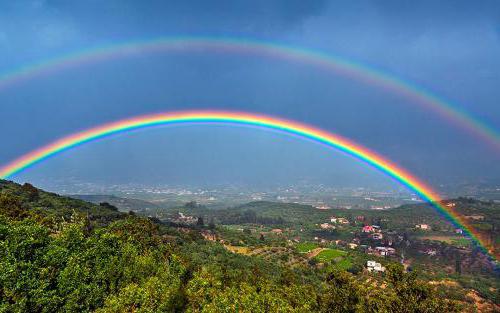Many people like funny pictures that trick their visual perception. But did you know that nature also knows how to create optical illusions? Moreover, they look an order of magnitude more impressive than those made by man. These include dozens of natural phenomena and formations, both rare and fairly widespread. Northern lights, halo, green ray, lenticular clouds - only a small part of them. For your attention - 25 stunning optical illusions created by nature.
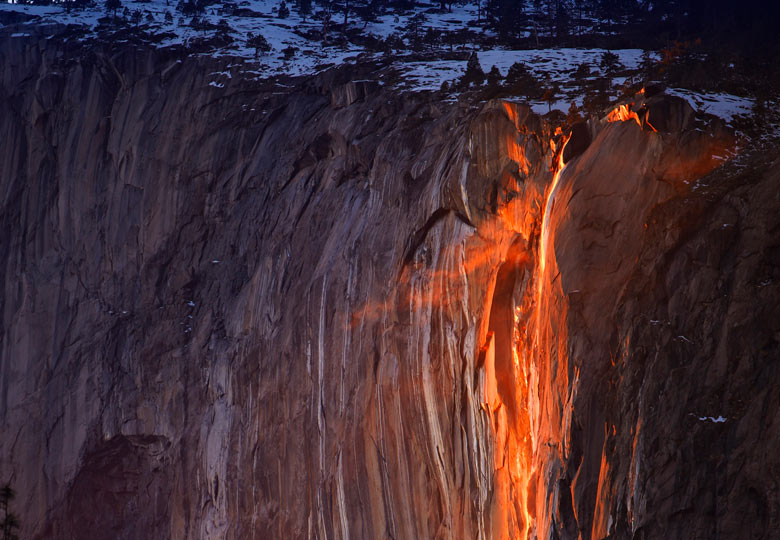
Every February the streams turn a fiery orange
This beautiful and at the same time intimidating waterfall is located in the central part of Yosemite National Park. It is called Horsetail Fall (translated as "horse tail"). Every year, during 4-5 February days, tourists can see the rarest phenomenon- the rays of the setting sun are reflected in the falling streams of water. At these moments, the waterfall turns into a fiery orange color. It seems that incandescent lava flows from the top of the mountain, but this is just an optical illusion.
The Horse Tail Waterfall consists of two cascading streams, its total height reaches 650 meters.
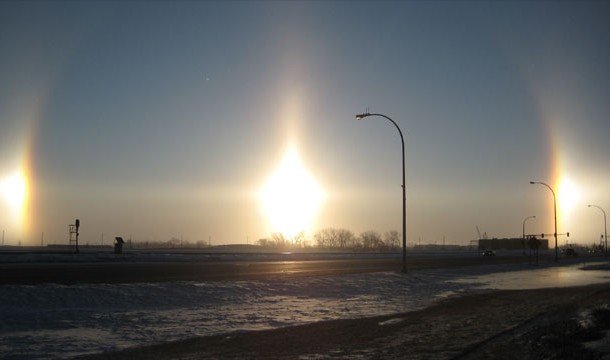
Real Sun and two false
If the Sun is low above the horizon and microscopic ice crystals are present in the atmosphere, observers may notice several bright iridescent specks to the right and left of the Sun. These bizarre halos faithfully follow our luminary across the firmament, in whatever direction it is directed.
In principle, this atmospheric phenomenon is considered to be quite common, but the effect is difficult to notice.
This is interesting: On the rare occasion that sunlight passes through cirrus clouds at the correct angle, these two spots become as bright as the Sun itself.
The effect is best observed in the early morning or late evening in the polar regions.

Fata morgana - the rarest optical illusion
Fata morgana is a complex optical atmospheric phenomenon. It is extremely rare. In fact, Fata Morgana "consists" of several forms of mirages, due to which distant objects are distorted and "bifurcated" for the observer.
It is known that Fata Morgana occurs when several alternating layers of air with different densities are formed in the lower atmosphere (usually due to temperature differences). Under certain conditions, they give mirror reflections.
Due to the reflection and refraction of light rays, real-life objects can create several distorted images on the horizon or even above it at once, which partially overlap each other and rapidly change over time, thereby creating a striking picture of Fata Morgana.

A pillar of light emanating from the sun descending beyond the horizon
We become witnesses of light (or solar) pillars quite often. This is the name of a common type of halo. This optical effect looks like a vertical streak of light that extends from the sun at sunset or sunrise. A column of light can be observed when light in the atmosphere bounces off the surface of tiny ice crystals in the form of ice plates or miniature hexagonal rods. Crystals of this shape are most often formed in high cirrostratus clouds. But if the air temperature is low enough, they can appear in less high layers of the atmosphere. We think it is not worth explaining why light columns are most often observed in winter.

Under certain conditions, the shadow can look like a ghost.
When there is a thick fog outside, you can observe an interesting optical phenomenon - the so-called Broken ghost. To do this, you just need to turn your back to the main light source. The observer will be able to see his own shadow lying on the fog (or cloud if you are in a mountainous area).
This is interesting: If the light source, as well as the object on which the shadow is cast, are static, it will repeat any movement of a person. But in a completely different way, the shadow will be displayed on a moving "surface" (for example, on fog). In such conditions, it can oscillate, creating the illusion that a dark, foggy silhouette is moving. One gets the impression that this is not a shadow belonging to the observer, but a real ghost.
Atlantic road

It seems as if this bridge is not completed
There are probably no more scenic highways in the world than the Atlantic Road in Møre og Romsdal, Norway. A unique highway runs across the north coast Atlantic Ocean and includes as many as 12 bridges connecting individual islands with a road surface.
The most amazing place Atlantic Road - Storseisundet Bridge. From a certain angle, it may seem that it is not completed, and all passing cars, going up, approach the cliff, and then fall down.
The total length of this bridge, opened in 1989, is 8.3 kilometers.
In 2005, the Atlantic Road was named “Norway's Building of the Century”. And the journalists of the British edition of The Guardian awarded it the title of the best tourist route in this northern country.
Moon illusion

The Moon, located above the horizon, seems to be large.
When the full moon bends low on the horizon, it is visually much larger than when it is high in the sky. This phenomenon is seriously puzzling thousands of inquisitive minds trying to find some reasonable explanation for it. But in reality, this is a common illusion.
The most straightforward way to confirm the illusory nature of this effect is to hold a small rounded object (for example, a coin) in your outstretched hand. Comparing the size of this object with the "huge" Moon at the horizon and the "tiny" Moon in the sky, you will be surprised, because you will understand that its relative size does not undergo any changes. You can also roll up a piece of paper in the shape of a tube and look through the hole formed exclusively at the Moon, without any objects surrounding it. Again, the illusion will disappear.
This is interesting: Most scientists, explaining the Lunar illusion, refer to the theory of "relative size". It is known that the visual perception of the size of an object visible by a person is determined by the dimensions of other objects observed by him at the same time. When the Moon is low above the horizon, other objects (houses, trees, etc.) fall into the field of view of a person. Against their background, our night star seems larger than it actually is.
Shadows of the clouds

Cloud shadows look like small islands
On a sunny day with great height it is very interesting to observe the shadows cast by clouds on the surface of our planet. They resemble small, constantly moving islands in the ocean. Unfortunately, ground-based observers will not be able to appreciate the magnificence of this picture.

Atlas moth practically does not fly
Huge moth atlas is found in rainforest in the South of Asia. It is this insect that holds the record for wing surface area (400 square centimeters). In India, this moth is bred to produce silk threads. The gigantic insect produces brown silk that looks like wool.
Due to their large size, atlas moths fly disgustingly, moving slowly and awkwardly in the air. But the unique coloring of their wings helps to disguise themselves in natural environment a habitat. Thanks to her, the atlas literally merges with the trees.

The illusion is created that dew drops are floating in the air
In the morning or after rain, tiny water droplets resembling a necklace can be seen on the cobwebs. If the web is very thin, the observer may have the illusion that the drops literally float in the air. And in the cold season, the cobweb can be covered with frost or frozen dew, such a picture looks no less impressive.

Green Beam Observed After Sunset
A short-term flash of green light, observed an instant before the appearance of the solar disk from the horizon (most often, at the sea) or at the moment when the sun is hiding behind it, is called a green ray.
You can become a witness of this amazing phenomenon if three conditions are met: the horizon must be open (steppe, tundra, sea, mountainous terrain), the air must be clean, and the region of sunset or sunrise must be free of clouds.
As a rule, the green beam is visible for no more than 2-3 seconds. To significantly increase the time interval of its observation at the time of sunset, you need to quickly run up the earthen embankment or climb stairs immediately after the appearance of the green ray. If the Sun rises, you need to move in the opposite direction, that is, down.
This is interesting: During one of the flights over the South Pole, the famous American pilot Richard Byrd saw a green ray for 35 minutes! A unique event occurred at the end of the polar night, when the upper edge of the solar disk first appeared over the horizon and slowly moved along it. It is known that at the poles the solar disk moves almost horizontally: the speed of its vertical rise is very low.
Physicists attribute the effect of the green ray to the refraction (i.e., refraction) of sunlight as it travels through the atmosphere. Interestingly, at the time of sunset or sunrise, we should have seen blue or purple rays first. But their wavelength is so small that when passing through the atmosphere, they are almost completely scattered and do not reach the terrestrial observer.

The peri-zenith arch looks like an inverted rainbow
In fact, the zenith arch looks like a rainbow turned upside down. To some people, it even resembles a huge multi-colored smiley face in the sky. This phenomenon is formed due to the refraction of the sun's rays passing through ice crystals of a certain shape soaring in the clouds. The arc centers at the zenith parallel to the horizon. The top color of this rainbow is blue, the bottom color is red.
Halo
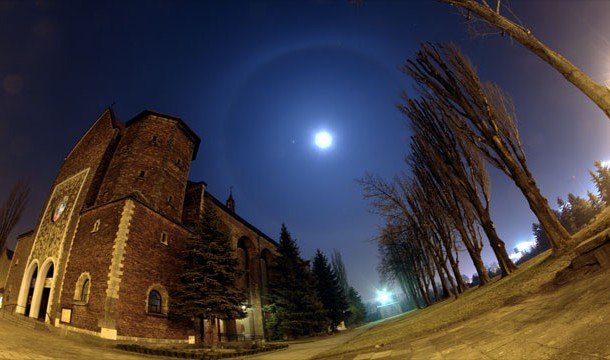
The luminous ring around the moon in the night sky is a halo
Halo is one of the most famous optical phenomena, observing which a person can see a luminous ring around a powerful light source.
During the day, the halo appears around the sun, at night - around the moon or other sources, for example, street lamps. There are many types of halos (one of them is the aforementioned false sun illusion). Almost all halos are caused by the refraction of light as it passes through ice crystals, which are concentrated in cirrus clouds (located in the upper troposphere). The type of halo is determined by the shape and arrangement of these miniature crystals.

Mountains and other tall objects turn pinkish
Probably every inhabitant of our planet saw a pink glow. it interesting phenomenon observed at the moment when the sun sets over the horizon. Then mountains or other vertical objects (for example, multi-storey buildings) are painted in a pale pink shade for a short time.
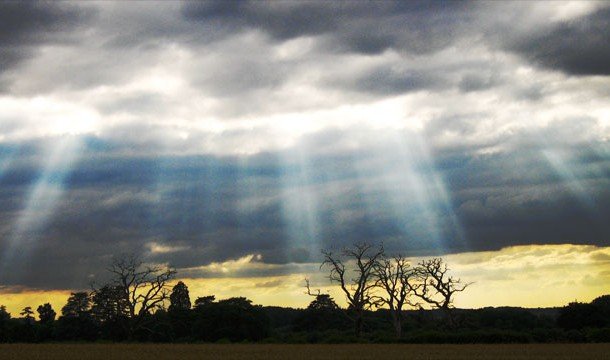
Twilight rays are observed in cloudy weather
Scientists call twilight rays a common optical phenomenon that looks like the alternation of many light and dark stripes in the firmament. Moreover, all these stripes diverge from the current location of the Sun.
Twilight rays are one of the manifestations of the play of light and shadow. We are sure that the air is completely transparent, and the rays of light that pass through it are invisible. But in the case of the presence of the smallest droplets of water or dust particles in the atmosphere, sunlight is scattered. A whitish haze forms in the air. It is almost invisible in clear weather. But in cloudy conditions, dust or water particles that are in the shadow of clouds are less illuminated. Therefore, shaded areas are perceived by observers as dark stripes. Well-lit areas alternating with them, on the contrary, seem to us as bright light stripes.
A similar effect is observed when the sun's rays, making their way through the cracks into a dark room, form bright light paths, illuminating dust particles floating in the air.
This is interesting: The twilight rays are called in different countries differently. The Germans use the expression “The sun drinks water”, the Dutch use the expression “The sun is on its feet”, and the British call the twilight rays “Jacob's ladder” or “the ladder of angels”.
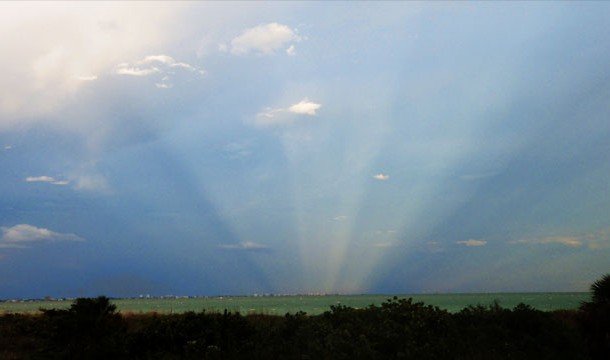
Anti-twilight rays emanate from a point on the horizon opposite the setting sun
These rays are observed at the time of sunset on the eastern side of the firmament. They, like the twilight rays, fan out, the only difference between them is their location relative to the celestial body.
It may seem that the anti-twilight rays are converging at some point beyond the horizon, but this is only an illusion. In fact, the rays of the Sun propagate strictly along straight lines, but when these lines are projected onto the spherical atmosphere of the Earth, arcs are formed. That is, the illusion of their fan-shaped divergence is determined by the perspective.
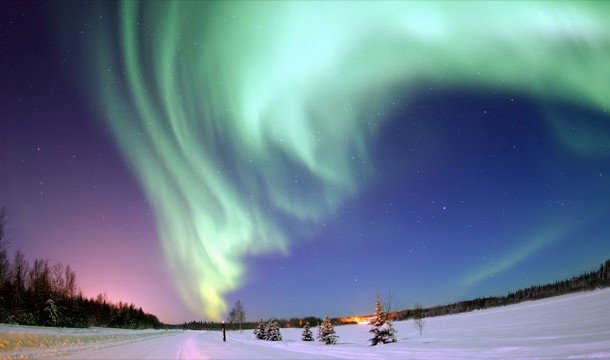
Northern lights in the night sky
The sun is very unstable. Sometimes powerful explosions occur on its surface, after which the smallest particles of solar matter (solar wind) are directed towards the Earth at great speed. It takes them about 30 hours to reach Earth.
The magnetic field of our planet deflects these particles to the poles, as a result of which extensive magnetic storms begin there. Protons and electrons entering the ionosphere from outer space interact with it. The thin layers of the atmosphere begin to glow. The whole sky is painted with multi-colored dynamically moving patterns: arcs, bizarre lines, crowns and spots.
This is interesting: you can observe the aurora borealis in high latitudes of each hemisphere (therefore, it would be more correct to call this phenomenon "aurora borealis"). The geography of the places where people can contemplate this impressive natural phenomenon expands significantly only during periods of high solar activity. Surprisingly, there are also auroras on other planets in our solar system.
The shapes and colors of the colorful glow of the night sky change rapidly. Interestingly, auroras occur exclusively in the altitude ranges from 80 to 100 and from 400 to 1000 kilometers above ground level.

Buckthorn is a butterfly with incredibly realistic natural camouflage
In early April, when the weather is stable and warm and sunny, you can see a beautiful light speck flitting from one spring flower to another. This is a butterfly called buckthorn or lemongrass.
The wingspan of the buckthorn is about 6 centimeters, the length of the wings is from 2.7 to 3.3 centimeters. Interestingly, the coloration of males and females is different. Males have bright greenish lemon wings, and females are lighter, almost white.
Krušinitsa has amazingly realistic natural camouflage. It is very difficult to distinguish it from plant leaves.
Magnetic hill

Cars seem to be rolling uphill under the influence of an unknown force
There is a hill in Canada where extraordinary things happen. Having parked the car near its foot and engaging in neutral, you will see that the car begins to roll (without any help) upward, that is, in the direction of the rise. Many people attribute the amazing phenomenon to the effect of an incredibly powerful magnetic force that makes cars roll uphill and reach speeds of up to 40 kilometers per hour.
Unfortunately, there is no magnetism or magic here. It's all about the usual optical illusion. Due to the peculiarities of the relief, a small slope (about 2.5 degrees) is perceived by the observer as an ascent upward.
A major factor in creating a similar illusion seen elsewhere the globe, - zero or minimum visibility of the horizon. If a person does not see it, then it becomes quite difficult to judge the inclination of the surface. Even objects, in most cases located perpendicular to the ground (for example, trees), can lean in any direction, misleading the observer even more.
Salt deserts
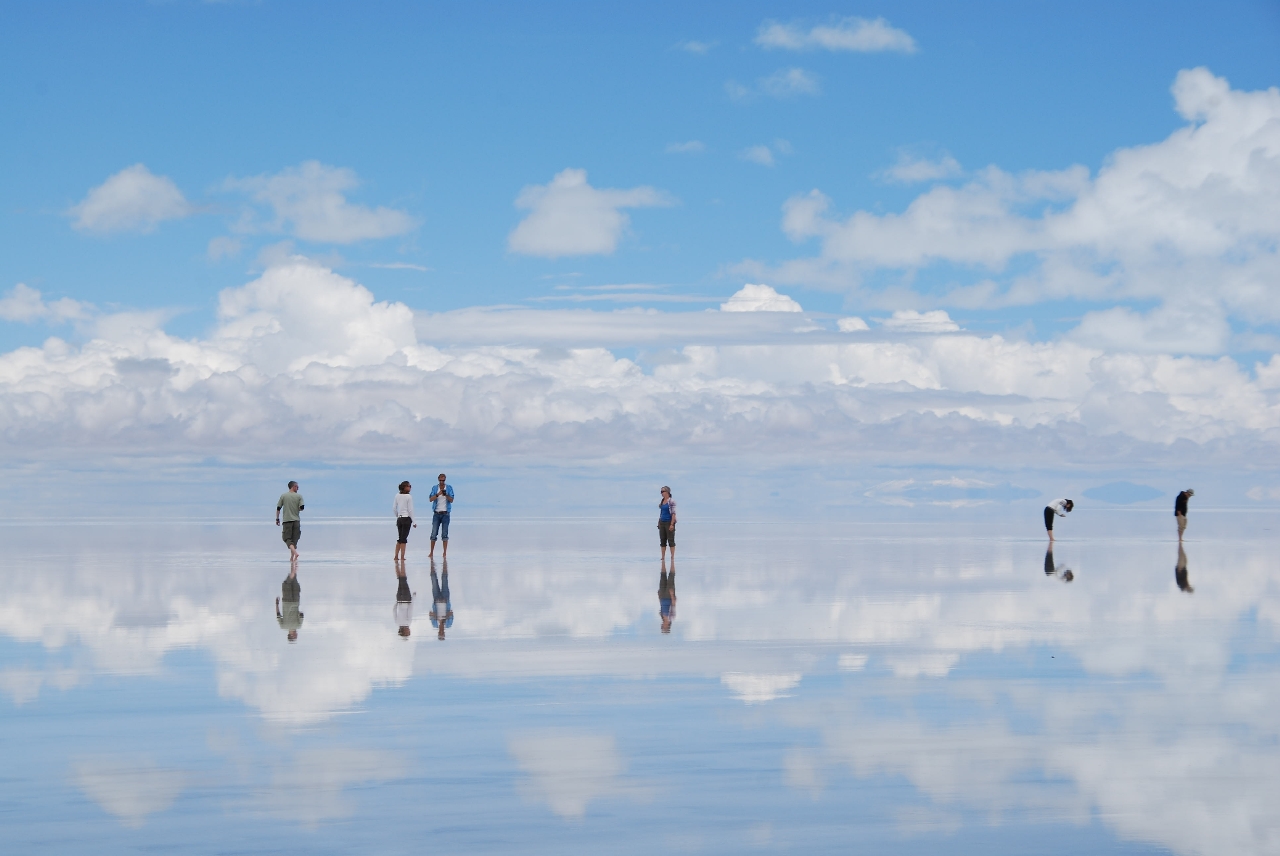
It seems like all these people are soaring in the sky.
Salt deserts are found in all corners of the earth. People in the middle of them have a distorted perception of space due to the lack of any reference points.
In the photo you can see a dried-up salt lake located in the southern part of the Altiplano plain (Bolivia) and called the Uyuni Salt Flats. This place is located at an altitude of 3.7 kilometers above sea level, and its total area exceeds 10.5 thousand square kilometers. Uyuni is the largest salt marsh on our planet.
The most common minerals found here are halite and gypsum. And the thickness of the salt layer on the surface of the salt marsh in some places reaches 8 meters. The total salt reserves are estimated at 10 billion tons. On the territory of Uyuni there are several hotels built from salt blocks. Furniture and other interior items are also made from it. And on the walls of the rooms there are announcements: the administration politely asks guests not to lick anything. By the way, you can spend the night in such hotels for only $ 20.
Interesting: During the rainy season, Uyuni is covered with a thin layer of water, making it the largest mirror surface on Earth. In the midst of an infinite mirror space, observers have the impression that they are soaring in the sky or even on another planet.
Wave
![]()
Sand dunes turned to stone
Wave - A naturally formed gallery of sand and rock located on the border American states Utah and Arizona. Popular in the USA are nearby National parks Therefore, the Wave attracts hundreds of thousands of tourists every year.
Scientists claim that these unique rocky formations have been forming for more than one million years: sand dunes under the influence of conditions environment gradually hardened. And the wind and rain, which for a long time influenced these formations, polished their forms and gave them such an unusual look.
Apache head
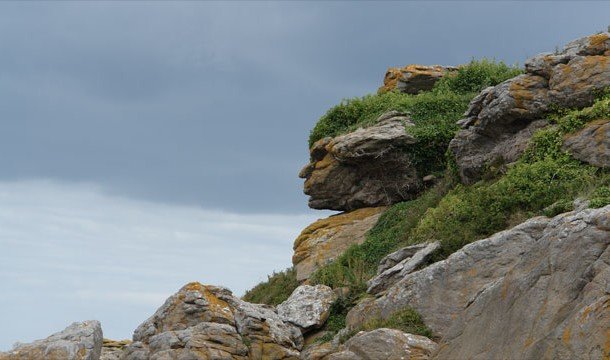
It's hard to believe that this rocky formation formed without human intervention.
This natural rock formation in France vividly illustrates our ability to recognize familiar shapes, such as human faces, in surrounding objects. Scientists recently discovered that we even have a special part of the brain that is responsible for recognizing faces. Interestingly, the visual perception of a person is designed in such a way that any objects similar in outlines to faces are noticed by us faster than other visual stimuli.
There are hundreds of natural formations in the world that exploit this human ability. But agree: mountain range the Apache head is probably the most striking of them all. By the way, tourists who had the opportunity to contemplate this unusual rocky formation located in the French Alps cannot believe that it was formed without human intervention.
Wasteland Guard

An Indian in a traditional headdress and headphones in his ears - where else can you see that?
Wasteland Guardian (also called "Indian Head") is a unique geoformation located near the Canadian city of Madisen Hat (southeastern part of the province of Alberta). When looking at it from a great height, it becomes obvious that the relief of the area forms the outlines of the head of a local aborigine in a traditional Indian headdress, staring somewhere to the west. Moreover, this Indian also listens to modern headphones.
In fact, what looks like a wire from a headphone is the path that leads to the oil rig, and the liner is the well itself. The height of the "Indian head" is 255 meters, the width is 225 meters. By comparison, the famous Mount Rushmore bas-relief, which carved the faces of four American presidents, is only 18 meters high.
Wasteland was formed naturally by the weathering and erosion of soft clay-rich soil. According to scientists, the age of this geoformation does not exceed 800 years.
Lenticular (lenticular) clouds
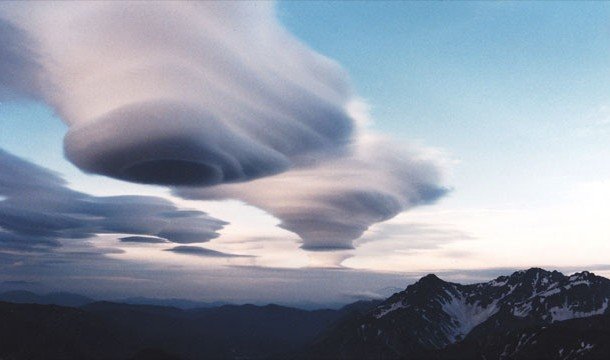
Lenticular clouds look like huge UFOs
A unique feature of lenticular clouds is that no matter how strong the wind is, they remain stationary. Air currents sweeping over ground surface, obstacles flow around, due to this, air waves... At their edges, lenticular clouds are formed. In their lower part, there is a continuous process of condensation of water vapor rising from the surface of the earth. Therefore, lenticular clouds do not change their position. They just hover in the sky in one place.
Lenticular clouds most often form on the leeward side of mountain ranges or over individual peaks at an altitude of 2 to 15 kilometers. In most cases, their appearance signals an approaching atmospheric front.
Interesting: Because of their unusual shape and absolute immobility, people often mistake lenticular clouds for UFOs.
Thunderbolt clouds
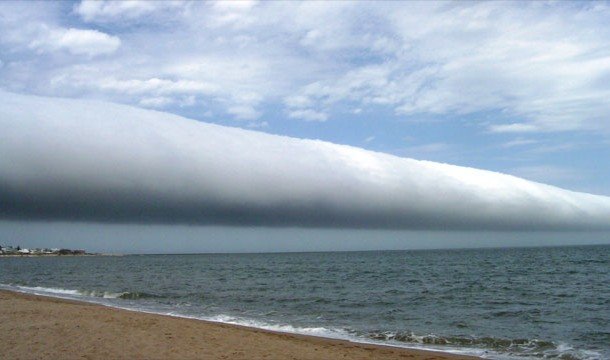
Such a sight inspires fear, you must admit!
Creepy clouds with a thunderstorm are seen quite often in flat areas. They sink very low above the ground. There is a feeling that if you go up to the roof of the building, you can reach them with your hand. And sometimes it may seem that such clouds are in general contact with the surface of the earth.
A storm shaft (another name is a squall gate) is visually similar to a tornado. Fortunately, compared to this natural phenomenon, he's not that dangerous. A thunderbolt is simply a low, horizontally oriented area of a thundercloud. It is formed in its front part during fast movement. And the squall gate acquires an even and smooth shape under conditions of active ascending air movement. Such clouds, as a rule, form during the warm season (from mid-spring to mid-autumn). Interestingly, the life span of thunderstorms is very short - from 30 minutes to 3 hours.
Agree, many of the above phenomena seem truly magical, even though their mechanisms can be easily explained from a scientific point of view. Nature, without the slightest human participation, creates amazing optical illusions that amaze the imagination of even many researchers who have seen in their lifetime. How can one not admire her greatness and power?
Lyceum Petru Movila
Course work in physics on the topic:
Optical atmospheric phenomena
The work of a student of grade 11A
Bolubash Irina
Chisinau 2006 -
Plan:
1. Introduction
a) What is optics?
b) Types of optics
2.
3. Sunny sunset
a) Color change the sky
b) Sun rays
v) The uniqueness of sunsets
4. Rainbow
a) Rainbow formation
b) Variety of rainbows
5. Polar lights
a) Types of polar lights
b) Solar wind as the cause of the aurora
6. Halo
a) Light and ice
b) Crystals-prisms
7. Mirage
a) Explanation of the lower ("lake") mirage
b) Upper mirages
v) Double and triple mirages
G) Ultra Far Vision Mirage
e) Alpine legend
e) Superstition parade
8.
Introduction
What is optics?
The first ideas of the ancient scientists about light were very naive. It was believed that special thin tentacles emerge from the eyes and visual impressions arise when they touch objects. At that time, optics was understood as the science of vision. This is the exact meaning of the word "optics". In the Middle Ages, optics gradually turned from the science of vision into the science of light. This was facilitated by the invention of lenses and a pinhole camera. V modern times optics is a branch of physics that studies the emission of light, its propagation in various media and interaction with matter. As for the issues related to vision, the structure and functioning of the eye, they have emerged in a special scientific area called physiological optics.
The concept of "optics", in modern science, has a multifaceted meaning. These are atmospheric optics, and molecular optics, and electronic optics, and neutron optics, and nonlinear optics, and holography, and radio optics, and picosecond optics, and adaptive optics, and many other phenomena and methods of scientific research closely related to optical phenomena.
Most of the listed types of optics, as physical phenomenon are available to our supervision only when using special technical devices. These can be lasers, X-ray emitters, radio telescopes, plasma generators, and much more. But the most accessible and, at the same time, the most colorful optical phenomena are atmospheric. Huge in scale, they are the product of the interaction of light and the atmosphere of the earth.
Earth's atmosphere as an optical system
Our planet is surrounded by a shell of gas that we call the atmosphere. Possessing the highest density at the earth's surface and gradually thinning with rising upward, it reaches a thickness of more than a hundred kilometers. And this is not a frozen gas medium with homogeneous physical data. On the contrary, the earth's atmosphere is in constant motion. Under the influence of various factors, its layers mix, change density, temperature, transparency, move long distances at different speeds.
For the rays of light coming from the sun or other celestial bodies, the earth's atmosphere is a kind of optical system with constantly changing parameters. Finding itself in their path, it reflects part of the light, scatters it, passes it through the entire thickness of the atmosphere, providing illumination of the earth's surface, under certain conditions, decomposes it into its components and bends the course of the rays, thereby causing various atmospheric phenomena. The most unusual colorful of them are sunset, rainbow, northern lights, mirage, solar and lunar halo.
Sunny sunset
The simplest and most accessible atmospheric phenomenon for observation is the sunset of our heavenly body - the Sun. Extraordinarily colorful, it never repeats itself. And the picture of the sky and its change during the sunset is so vivid that it delights every person.
Approaching the horizon, the Sun not only loses its brightness, but also begins to gradually change its color - in its spectrum, the short-wavelength part (red colors) is increasingly suppressed. At the same time, the sky begins to color. In the vicinity of the Sun, it acquires yellowish and orange tones, and a pale stripe with a weakly expressed gamut of colors appears above the anti-sun part of the horizon.By the time the Sun sets, which has already assumed a dark red color, a bright streak of dawn stretches along the solar horizon, the color of which changes from bottom to top from orange-yellow to greenish-blue. A rounded, bright, almost uncolored glow spreads over it. At the same time, a bluish-gray, dull segment of the Earth's shadow, bordered by a pink belt, begins to slowly rise at the opposite horizon. ("Belt of Venus").
 As the Sun sinks deeper under the horizon, a rapidly spreading pink spot appears - the so-called "purple light", reaching the greatest development when the depth of the Sun under the horizon is about 4-5 o. Clouds and mountain peaks fill with scarlet and purple tones, and if the clouds or high mountains are beyond the horizon, then their shadows extend near the sunny side of the sky and become richer. At the very horizon, the sky turns red thickly, and across the brightly colored sky from horizon to horizon, light rays stretch in the form of distinct radial stripes ("Beams of the Buddha"). Meanwhile, the shadow of the Earth is rapidly approaching the sky, its outlines become blurry, and the pink edging is barely noticeable.
As the Sun sinks deeper under the horizon, a rapidly spreading pink spot appears - the so-called "purple light", reaching the greatest development when the depth of the Sun under the horizon is about 4-5 o. Clouds and mountain peaks fill with scarlet and purple tones, and if the clouds or high mountains are beyond the horizon, then their shadows extend near the sunny side of the sky and become richer. At the very horizon, the sky turns red thickly, and across the brightly colored sky from horizon to horizon, light rays stretch in the form of distinct radial stripes ("Beams of the Buddha"). Meanwhile, the shadow of the Earth is rapidly approaching the sky, its outlines become blurry, and the pink edging is barely noticeable.  Gradually, the purple light fades, the clouds darken, their silhouettes stand out clearly against the background of the fading sky, and only near the horizon, where the Sun has hidden, a bright multi-colored segment of the dawn is preserved. But it, too, gradually diminishes and fades, and by the beginning of the astronomical twilight turns into a greenish-whitish narrow strip. Finally, she disappears too - the night comes.
Gradually, the purple light fades, the clouds darken, their silhouettes stand out clearly against the background of the fading sky, and only near the horizon, where the Sun has hidden, a bright multi-colored segment of the dawn is preserved. But it, too, gradually diminishes and fades, and by the beginning of the astronomical twilight turns into a greenish-whitish narrow strip. Finally, she disappears too - the night comes. The described picture should be considered only as typical for clear weather. In fact, the course of a sunset is subject to wide variations. With increased turbidity of the air, the colors of the dawn are usually faded, especially near the horizon, where instead of red and orange tones, sometimes only a faint brown color appears. Quite often, simultaneous glowing phenomena develop in different ways in different parts of the sky. Each sunset has a unique personality, and this should be seen as one of their most characteristic features.
The extreme individuality of the course of the sunset and the variety of accompanying optical phenomena depend on various optical characteristics of the atmosphere - first of all, its attenuation and scattering coefficients, which manifests itself in different ways depending on the zenith distance of the Sun, the direction of observation and the observer's height.
Rainbow
A rainbow is observed on the opposite side of the Sun, against a background of rain clouds or rain. A multi-colored arc is usually located at a distance of 1-2 km from the observer, and sometimes it can be observed at a distance of 2-3 m against the background of water droplets formed by fountains or water sprays.
The center of the rainbow is located on the continuation of the straight line connecting the Sun and the observer's eye - on the anti-solar line. The angle between the direction to the main rainbow and the anti-sun line is 41º - 42º
At the moment of sunrise, the anti-sun point is on the horizon, and the rainbow looks like a semicircle. As the Sun rises, the anti-sun point drops below the horizon and the size of the rainbow decreases. It represents only part of a circle.
A collateral rainbow is often observed, concentric with the first, with an angular radius of about 52º and reversed colors.
The main rainbow is formed by the reflection of light in water droplets. And a side rainbow is formed as a result of two reflections of light inside each drop. In this case, the rays of light come out of the drop at different angles than those that give rise to the main rainbow, and the colors in the secondary rainbow are in reverse order.
The path of rays in a drop of water: a - with one reflection, b - with two reflections
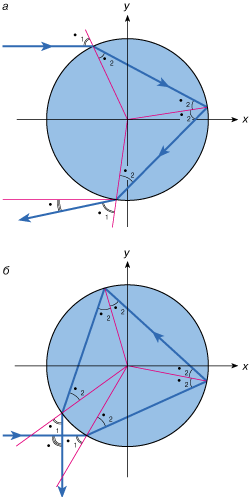
When the Sun's height is 41º, the main rainbow is no longer visible and only a part of the subsidiary rainbow protrudes above the horizon, and when the Sun is more than 52º, the subsidiary rainbow is not visible either. Therefore, in the middle equatorial latitudes this natural phenomenon is never observed at around noon.
 The rainbow has seven primary colors, smoothly passing one into the other. The type of arc, the brightness of the colors, the width of the stripes depend on the size of the water droplets and their number. Large drops create a narrower rainbow with sharply distinguished colors, small drops create a blurry, faded and even white arc. That's why bright narrow rainbow visible in the summer after a thunderstorm, during which large drops fall.
The rainbow has seven primary colors, smoothly passing one into the other. The type of arc, the brightness of the colors, the width of the stripes depend on the size of the water droplets and their number. Large drops create a narrower rainbow with sharply distinguished colors, small drops create a blurry, faded and even white arc. That's why bright narrow rainbow visible in the summer after a thunderstorm, during which large drops fall. The rainbow theory was first given in 1637 by René Descartes. He explained the rainbow as a phenomenon associated with the reflection and refraction of light in raindrops. The formation of colors and their sequence were explained later, after solving the complex nature of white light and its dispersion in the medium.
Rainbow formation
You can consider the simplest case: let a beam of parallel sun rays fall on the droplets in the shape of a ball. A ray falling on the surface of a drop at point A is refracted inside it according to the law of refraction: n sin α = n sin β , where n =1, n ≈1,33 - respectively, the refractive indices of air and water, α Is the angle of incidence, and β Is the angle of refraction of light.
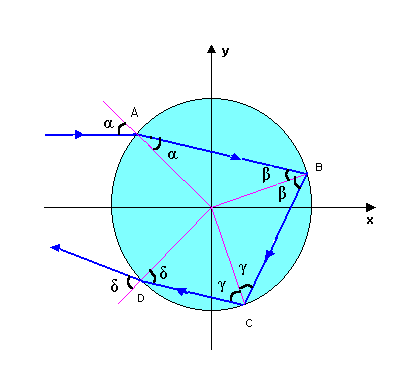 Beam AB goes in a straight line inside the drop. At point B, the ray is partially refracted and partially reflected. It should be noted that the smaller the angle of incidence at point B, and therefore at point A, the lower the intensity of the reflected beam and the greater the intensity of the refracted beam.
Beam AB goes in a straight line inside the drop. At point B, the ray is partially refracted and partially reflected. It should be noted that the smaller the angle of incidence at point B, and therefore at point A, the lower the intensity of the reflected beam and the greater the intensity of the refracted beam. Beam AB after reflection at point B occurs at an angle β '= β and hits point C, where partial reflection and partial refraction of light also occurs. The refracted ray leaves the drop at an angle γ, while the reflected one can pass further, to point D, etc. Thus, the light ray in the drop undergoes multiple reflection and refraction. With each reflection, some part of the light rays goes out and their intensity decreases inside the drop. The most intense of the rays that go out into the air is the ray that came out of the drop at point B. But it is difficult to observe it, since it is lost against the background of bright direct sunlight. On the other hand, the rays refracted at point C together create a primary rainbow against the background of a dark cloud, and rays refracted at point D produce a secondary rainbow that is less intense than the primary one.
When considering the formation of a rainbow, one more phenomenon must be taken into account - the unequal refraction of light waves of different lengths, that is, light rays of different colors. This phenomenon is called variance. Due to dispersion, the angles of refraction γ and the angle of deflection of rays in a droplet are different for rays of different colors.
A rainbow occurs due to the dispersion of sunlight in water droplets. In each droplet, the beam undergoes multiple internal reflection, but with each reflection, some of the energy goes out. Therefore, the more internal reflections the rays in the drop experience, the weaker the rainbow. You can observe a rainbow if the Sun is behind the observer. Therefore, the brightest, primary rainbow is formed from rays that have experienced one internal reflection. They cross the incident rays at an angle of about 42 °. The locus of points located at an angle of 42 ° to the incident ray is a cone perceived by the eye at its apex as a circle. When illuminated with white light, a colored stripe will be obtained, with the red arc always above the violet.
Most often we see one rainbow. There are frequent cases when two rainbow stripes appear simultaneously in the firmament, located one after the other; an even greater number of celestial arcs are observed - three, four and even five at the same time. It turns out that a rainbow can arise not only from direct rays; quite often it appears in the reflected rays of the sun. This can be seen on the shores of the sea bays, big rivers and lakes. Three or four rainbows - ordinary and reflected - sometimes create a beautiful picture. Since the rays of the Sun reflected from the water surface go from bottom to top, the rainbow formed in the rays can sometimes look completely unusual.
One should not think that a rainbow can only be observed during the day. It happens at night, but it is always weak. You can see such a rainbow after a night rain, when the moon looks out from behind the clouds.
Some semblance of a rainbow can be obtained on such experience : Need a flask filled with water, illuminate with sunlight or a lamp through a hole in the white board. Then a rainbow will become clearly visible on the board, and the angle of divergence of the rays in comparison with the initial direction will be about 41 ° - 42 °. Under natural conditions, there is no screen, the image appears on the retina of the eye, and the eye projects this image onto the clouds.
If a rainbow appears in the evening before sunset, then a red rainbow is observed. In the last five or ten minutes before sunset, all colors of the rainbow, except red, disappear, it becomes very bright and visible even ten minutes after sunset.
A beautiful sight is the rainbow on the dew. It can be observed at sunrise on the dew-covered grass. This rainbow has a hyperbole shape.
Polar lights
 One of the most beautiful optical phenomena in nature is the aurora borealis.
One of the most beautiful optical phenomena in nature is the aurora borealis. In most cases, auroras are green or blue-green with occasional spots or a pink or red border.
Auroras are observed in two main forms - in the form of ribbons and in the form of cloud-like spots. When the radiance is intense, it takes on the form of ribbons. Losing intensity, it turns into spots. However, many tapes disappear before they break into spots. The ribbons seem to hang in the dark space of the sky, resembling a giant curtain or drapery, usually stretching from east to west for thousands of kilometers. The height of this curtain is several hundred kilometers, its thickness does not exceed several hundred meters, and it is so delicate and transparent that the stars are visible through it. The lower edge of the curtain is quite sharply and distinctly outlined and is often tinted red or pinkish, reminiscent of the border of the curtain, the upper edge is gradually lost in height and this creates a particularly effective impression of the depth of space.
There are four types of auroras:
 Uniform arc- the luminous strip has the simplest, quietest shape. It is brighter from below and gradually disappears upward against the background of the glow of the sky;
Uniform arc- the luminous strip has the simplest, quietest shape. It is brighter from below and gradually disappears upward against the background of the glow of the sky; Radiant arc- the tape becomes somewhat more active and mobile, it forms small folds and trickles;
Radiant stripe- with an increase in activity, larger folds are superimposed on small ones;
With increased activity, the folds or loops expand to an enormous size, the lower edge of the ribbon shines brightly with a pink glow. When the activity subsides, the folds disappear and the tape returns to a uniform shape. This suggests that a homogeneous structure is the main form of the aurora, and wrinkles are associated with increased activity.
Auroras of a different kind often appear. They cover the entire polar region and are very intense. They occur during an increase in solar activity. These auroras appear as a whitish-green cap. Such shines are called squalls.
In terms of brightness, auroras are divided into four classes, differing from each other by one order of magnitude (that is, 10 times). The first class includes auroras that are barely noticeable and approximately equal in brightness to the Milky Way, while the fourth class illuminates the Earth as brightly as the full moon.
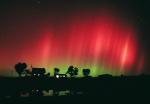 It should be noted that the resulting aurora spreads westward at a speed of 1 km / sec. The upper layers of the atmosphere in the area of auroral flares are heated and rush upward. During auroras, eddy electric currents arise in the Earth's atmosphere, covering large areas. They generate additional unstable magnetic fields, the so-called magnetic storms. During auroras, the atmosphere emits X-rays, which appear to be the result of deceleration of electrons in the atmosphere.
It should be noted that the resulting aurora spreads westward at a speed of 1 km / sec. The upper layers of the atmosphere in the area of auroral flares are heated and rush upward. During auroras, eddy electric currents arise in the Earth's atmosphere, covering large areas. They generate additional unstable magnetic fields, the so-called magnetic storms. During auroras, the atmosphere emits X-rays, which appear to be the result of deceleration of electrons in the atmosphere. Intense flashes of aurora are often accompanied by sounds resembling noise, crackling. Auroras cause strong changes in the ionosphere, which in turn affect the conditions of radio communication. In most cases, radio communications are significantly impaired. There is strong interference and sometimes complete loss of reception.
How aurora comes from

The earth is a huge magnet, the south pole of which is near the geographic north pole and the north pole near the south. The lines of force of the Earth's magnetic field, called geomagnetic lines, emerge from the area adjacent to the north magnetic pole of the earth, encompass the globe and enter it in the area of the south magnetic pole, forming a toroidal grid around the earth.
For a long time it was believed that the arrangement of magnetic lines of force is symmetrical about the earth's axis. Now it turned out that the so-called "solar wind" - the flow of protons and electrons emitted by the Sun, hit the Earth's geomagnetic shell from an altitude of about 20,000 km, pulls it back, away from the Sun, forming a kind of magnetic "tail" around the Earth.
 An electron or a proton, trapped in the Earth's magnetic field, moves in a spiral, as if winding on a geomagnetic line. Electrons and protons trapped from the solar wind into the Earth's magnetic field are divided into two parts. Some of them, along the magnetic lines of force, immediately flow down into the polar regions of the Earth; others fall into the interior of the theroid and move within it, along a closed curve. These protons and electrons eventually also flow along the geomagnetic lines to the region of the poles, where their increased concentration arises. Protons and electrons produce ionization and excitation of atoms and molecules of gases. For this, they have enough energy, since protons arrive at the Earth with energies of 10,000-20,000 eV (1ev = 1.6 10 J), and electrons with energies of 10-20 eV. For the ionization of atoms it is necessary: for hydrogen - 13.56 eV, for oxygen - 13.56 eV, for nitrogen - 124.47 eV, and even less for excitation.
An electron or a proton, trapped in the Earth's magnetic field, moves in a spiral, as if winding on a geomagnetic line. Electrons and protons trapped from the solar wind into the Earth's magnetic field are divided into two parts. Some of them, along the magnetic lines of force, immediately flow down into the polar regions of the Earth; others fall into the interior of the theroid and move within it, along a closed curve. These protons and electrons eventually also flow along the geomagnetic lines to the region of the poles, where their increased concentration arises. Protons and electrons produce ionization and excitation of atoms and molecules of gases. For this, they have enough energy, since protons arrive at the Earth with energies of 10,000-20,000 eV (1ev = 1.6 10 J), and electrons with energies of 10-20 eV. For the ionization of atoms it is necessary: for hydrogen - 13.56 eV, for oxygen - 13.56 eV, for nitrogen - 124.47 eV, and even less for excitation. Excited atoms of gases give back the received energy in the form of light, similar to how it happens in tubes with a rarefied gas when currents are passed through them.
 Spectral study shows that the green and red glow belongs to excited oxygen atoms, infrared and violet - to ionized nitrogen molecules. Some oxygen and nitrogen emission lines are formed at an altitude of 110 km, and the red glow of oxygen - at an altitude of 200-400 km. Another weak source of red light are hydrogen atoms, which formed in the upper atmosphere from protons arriving from the Sun. Having captured an electron, such a proton turns into an excited hydrogen atom and emits red light.
Spectral study shows that the green and red glow belongs to excited oxygen atoms, infrared and violet - to ionized nitrogen molecules. Some oxygen and nitrogen emission lines are formed at an altitude of 110 km, and the red glow of oxygen - at an altitude of 200-400 km. Another weak source of red light are hydrogen atoms, which formed in the upper atmosphere from protons arriving from the Sun. Having captured an electron, such a proton turns into an excited hydrogen atom and emits red light. Auroral flares usually occur a day or two after solar flares. This confirms the connection between these phenomena. Recently, scientists have found that the auroras are more intense off the coasts of the oceans and seas.
But the scientific explanation of all the phenomena associated with the aurora faces a number of difficulties. For example, the exact mechanism of particle acceleration to the indicated energies is unknown, their trajectories in near-earth space are not completely clear, not everything converges quantitatively in the energy balance of ionization and excitation of particles, the mechanism of the formation of various types of glow is not completely clear, the origin of sounds is not clear.Halo
Sometimes the Sun looks like it is visible through a large lens. In fact, the image shows the effect of millions of lenses: ice crystals. As water freezes in the upper atmosphere, small, flat, hexagonal ice crystals of ice can form. The planes of these crystals, which whirl, gradually descend to the ground, most of the time oriented parallel to the surface. At sunrise or sunset, the observer's line of sight can pass through this very plane, and each crystal can act like a miniature lens that refracts sunlight. The combined effect can lead to a phenomenon called parhelia, or false sun. In the center of the picture, the sun is visible and two well-visible false suns around the edges. Behind the houses and trees are visible halos (halo - pronounced "o"), about 22 degrees in size, three solar columns, and an arch created by sunlight reflected by atmospheric ice crystals.
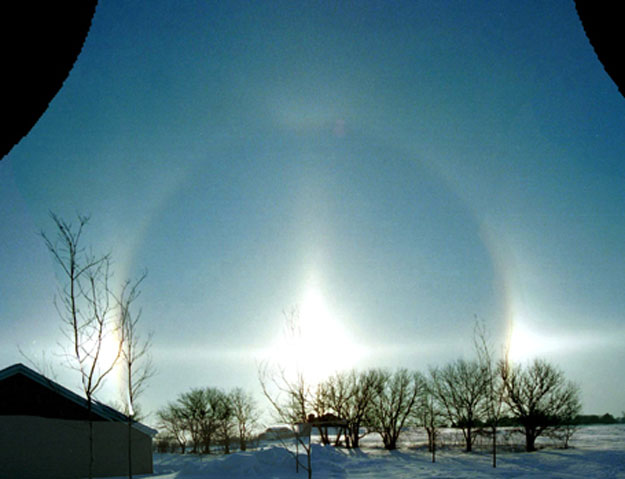
Light and ice
Researchers have long noticed that when a halo appears, the sun is obscured by a haze - a thin veil of high cirrus or cirrostratus clouds. Such clouds float in the atmosphere at a height of six to eight kilometers above the ground and consist of the smallest ice crystals, which are most often in the form of hexagonal columns or plates.
The earthly atmosphere knows no rest. Ice crystals, falling and rising in air currents, either reflect like a mirror, or like a glass prism refract the sun's rays falling on them. As a result of this complex optical game, false suns and other deceptive pictures appear in the sky, in which, if desired, you can see fiery swords and anything ...
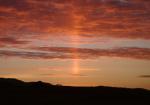 As already mentioned, more often than others, you can observe two false suns - on the one and the other side of the real star. Sometimes one light circle appears, slightly colored in rainbow tones, encircling the sun. And then, after sunset, a huge luminous column suddenly appears in the darkened sky.
As already mentioned, more often than others, you can observe two false suns - on the one and the other side of the real star. Sometimes one light circle appears, slightly colored in rainbow tones, encircling the sun. And then, after sunset, a huge luminous column suddenly appears in the darkened sky. Not all cirrus clouds produce a bright, highly visible halo. For this, it is necessary that they are not too dense (the sun shines through) and at the same time there must be a sufficient amount of ice crystals in the air. However, a halo can appear in a completely clear, cloudless sky. This means that there are many individual ice crystals floating high in the atmosphere, but no cloud formation. This happens on winter days, when the weather is clear and frosty.
...Above, a bright horizontal circle appeared, encircling the sky parallel to the horizon. How did it come about?
Special experiments (they have been repeatedly carried out by scientists) and calculations show that this circle is the result of the reflection of sunlight from the lateral faces of hexagonal ice crystals floating in the air in an upright position. The rays of the sun fall on such crystals, are reflected from them, as from a mirror, and fall into our eyes. And since this mirror is special, it is composed of an innumerable mass of ice particles and, moreover, appears to lie in the plane of the horizon for some time, then we see the reflection of the solar disk in the same plane. It turns out two suns: one is real, and next to it, but in a different plane, is its double in the form of a large light circle.
 It happens that this reflection of sunlight from small ice crystals floating in the frosty air generates a luminous column. It turns out this because here crystals in the form of plates participate in the play of light. The lower edges of the plates reflect the light of the sun already hidden behind the horizon, and instead of the sun itself we see a luminous path going into the sky from the horizon for some time - an image of the solar disk distorted beyond recognition. Each of us observed something similar on a moonlit night, standing on the shore of the sea or lake. Admiring the lunar path, we see the same play of light on the water - a mirror reflection of the moon, strongly stretched due to the fact that the surface of the water is covered with ripples. Slightly stirring water reflects the moonlight falling on it in such a way that we perceive, as it were, many dozens of individual reflections of the moon, from which the lunar path, praised by the poets, is formed.
It happens that this reflection of sunlight from small ice crystals floating in the frosty air generates a luminous column. It turns out this because here crystals in the form of plates participate in the play of light. The lower edges of the plates reflect the light of the sun already hidden behind the horizon, and instead of the sun itself we see a luminous path going into the sky from the horizon for some time - an image of the solar disk distorted beyond recognition. Each of us observed something similar on a moonlit night, standing on the shore of the sea or lake. Admiring the lunar path, we see the same play of light on the water - a mirror reflection of the moon, strongly stretched due to the fact that the surface of the water is covered with ripples. Slightly stirring water reflects the moonlight falling on it in such a way that we perceive, as it were, many dozens of individual reflections of the moon, from which the lunar path, praised by the poets, is formed. 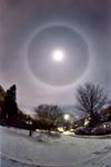 You can often observe the lunar halo. This is a fairly common sight and it occurs when the sky is covered with tall thin clouds with millions of tiny ice crystals. Each ice crystal acts as a miniature prism. Most crystals are in the form of elongated hexagons. Light enters through one face surface of such a crystal and exits through the opposite one with a refraction angle of 22º.
You can often observe the lunar halo. This is a fairly common sight and it occurs when the sky is covered with tall thin clouds with millions of tiny ice crystals. Each ice crystal acts as a miniature prism. Most crystals are in the form of elongated hexagons. Light enters through one face surface of such a crystal and exits through the opposite one with a refraction angle of 22º. And watch the street lamps in winter, and you may be lucky enough to see the halo generated by their light, under certain conditions, of course, namely, in the frosty air saturated with ice crystals or snowflakes. By the way, a halo from the sun in the form of a large pillar of light can also appear during a snowfall. There are days in winter when snowflakes seem to float in the air, and sunlight stubbornly breaks through the thin clouds. Against the background of the evening dawn, this pillar sometimes looks reddish - like a reflection of a distant fire. In the past, as we see, such a completely harmless phenomenon terrified superstitious people.
Crystals-prisms
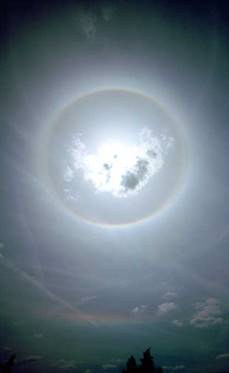 Perhaps someone has seen such a halo: a light, rainbow-colored ring around the sun. This vertical circle occurs when there are many six-sided ice crystals in the atmosphere that do not reflect, but refract the sun's rays like a glass prism. In this case, most of the rays, naturally, are scattered and do not reach our eyes. But some part of them, having passed through these prisms in the air and refracted, reaches us, so we see a rainbow circle around the sun. Its radius is about twenty-two degrees. It happens even more - at forty-six degrees.
Perhaps someone has seen such a halo: a light, rainbow-colored ring around the sun. This vertical circle occurs when there are many six-sided ice crystals in the atmosphere that do not reflect, but refract the sun's rays like a glass prism. In this case, most of the rays, naturally, are scattered and do not reach our eyes. But some part of them, having passed through these prisms in the air and refracted, reaches us, so we see a rainbow circle around the sun. Its radius is about twenty-two degrees. It happens even more - at forty-six degrees. Why rainbow?
As you know, passing through a prism, a white light beam decomposes into its spectral colors. Therefore, the ring formed by the refracted rays around the sun is painted in rainbow tones: its inner part is reddish, the outer part is bluish, and the sky seems darker inside the ring.
It is noticed that the halo circle is always brighter on the sides. This is because two halos intersect here - the vertical and the horizontal. And false suns are most often formed precisely at the intersection. The most favorable conditions for the appearance of false suns are formed when the sun is not high above the horizon and part of the vertical circle is no longer visible to us.
What crystals are involved in this "representation"?
The answer to the question was given by special experiments. It turned out that false suns appear thanks to hexagonal ice crystals, in their shape resembling ... nails. They float vertically in the air, refracting light with their side edges.
The third "sun" appears when only one upper part of the halo circle is visible above the real sun. Sometimes it is a segment of an arc, sometimes a bright spot of an indefinite shape. Sometimes false suns are as bright as the sun itself. Observing them, the ancient chroniclers wrote about the three suns, about the severed heads of fire, etc.
In connection with this phenomenon, an interesting fact has been recorded in the history of mankind. In 1551 german city Magdeburg was besieged by the troops of the Spanish king Charles V. The defenders of the city were holding on to the defenders for more than a year. Finally, the irritated king gave the order to prepare for a decisive attack. But then something unprecedented happened: a few hours before the assault, three suns began to shine over the besieged city. The mortally frightened king decided that Magdeburg was protected by the heavens, and ordered to lift the siege.
Mirage
The simplest mirages have been seen by any of us. For example, when driving on a heated asphalt road, far ahead it looks like a surface of water. And this does not surprise anyone for a long time, because mirage- nothing more than an atmospheric optical phenomenon, due to which images of objects appear in the visibility zone, which under normal conditions are hidden from observation. This happens because light is refracted when passing through layers of air of different density. In this case, distant objects may be raised or lowered relative to their actual position, and may also be distorted and acquire irregular, fantastic shapes.
Of the larger variety of mirages, we single out several types: "lake" mirages, also called lower mirages, upper mirages, double and triple mirages, ultra-long-range vision mirages.
Explanation of the lower ("lake") mirage.
 Lacustrine or inferior mirages are the most common. They appear when the distant, almost flat surface of the desert takes on the appearance of open water, especially when viewed from a slight elevation or simply being above a layer of heated air. A similar illusion arises just like on an asphalt road.
Lacustrine or inferior mirages are the most common. They appear when the distant, almost flat surface of the desert takes on the appearance of open water, especially when viewed from a slight elevation or simply being above a layer of heated air. A similar illusion arises just like on an asphalt road. If the air at the very surface of the earth is very hot and, therefore, its density is relatively low, then the refractive index at the surface will be lower than in higher air layers.
In accordance with the established rule, light rays near the surface of the earth will bend in this case so that their trajectory is curved downward. A ray of light from a certain area of the blue sky enters the eye of the observer, experiencing a curvature. This means that the observer will see the corresponding section of the sky not above the horizon line, but below it. It will seem to him that he sees water, although in fact in front of him is an image of a blue sky. If we imagine that there are hills, palms or other objects near the horizon, then the observer will see them upside down, due to the bending of the rays, and perceive them as reflections of the corresponding objects in non-existent water. Image shake caused by fluctuations in the refractive index of hot air creates the illusion of water flowing or stirring. This is how an illusion arises, which is a "lake" mirage.
 As reported in one article in the Journal
As reported in one article in the Journal nale The New Yorker, pelican, having
hovering over a hot asphalt highway
in the midwestern United States, almost once
fought, seeing in front of him such a "leading
noisy mirage. "" The unfortunate bird flew,
maybe many hours over dry
wheat stubble and unexpectedly
business is something that seemed to her a long, black, narrow, but real river - in the very heart of the prairie. The pelican rushed down to swim in the cool water - and lost consciousness, hitting the asphalt. "Below eye level, objects, usually inverted, can appear in this" water. " - the most heated and so rarefied that light waves, passing through it, are distorted, since the speed of their propagation changes depending on the density of the medium.
Upper mirages
Upper mirages, or, as they are also called, distant vision mirages are less common and more picturesque than the lower ones. Distant objects (often located beyond the sea horizon) appear upside down in the sky, and sometimes a direct image of the same object appears above. This phenomenon is typical for colder regions, especially with significant temperature inversion when there is a warmer layer of air above the colder layer. This optical effect is manifested as a result of the propagation of the front of light waves in layers of air with inhomogeneous density. Very unusual mirages appear from time to time, especially in the polar regions. When mirages appear on land, trees and other terrain components are inverted. In all cases, the objects in the upper mirages are seen more clearly than in the lower ones. There are places on the globe where, before the onset of evening, you can observe mountains rising above the ocean horizon. These are really mountains, only they are so far away
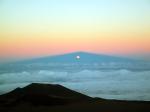 to the fact that they cannot be seen under normal conditions. In these mysterious places soon after noon, a vague outline of the mountains begins to appear on the horizon. It gradually grows and before sunset quickly becomes sharp, distinct, so that you can even distinguish individual peaks.
to the fact that they cannot be seen under normal conditions. In these mysterious places soon after noon, a vague outline of the mountains begins to appear on the horizon. It gradually grows and before sunset quickly becomes sharp, distinct, so that you can even distinguish individual peaks. The upper mirages are varied. In some cases they give an upright image, in other cases an inverted image appears in the air. Mirages can be double when two images are observed, a simple one and an inverted one. These images can be separated by a strip of air (one can be above the horizon line, the other below it), but they can directly close with each other. Sometimes another image appears - a third image.
Double and triple mirages
 If the refractive index of air changes rapidly at first and then slowly, then the rays will bend faster. The result is two images. Light rays propagating within the first air region form an inverted image of the object. Then these rays, spread mainly within the second region, are curved to a lesser extent and form a direct image.
If the refractive index of air changes rapidly at first and then slowly, then the rays will bend faster. The result is two images. Light rays propagating within the first air region form an inverted image of the object. Then these rays, spread mainly within the second region, are curved to a lesser extent and form a direct image. To understand how a triple mirage appears, you need to imagine three successive air regions: the first (near the surface), where the refractive index decreases slowly with height, the next, where the refractive index decreases rapidly, and the third region, where the refractive index decreases slowly again. First, the rays form the bottom image of the object, propagating within the first air region. Further, the rays form an inverted image; falling into the second air area, these rays experience a strong curvature. Then the rays form the upper direct image of the object.
Ultra Far Vision Mirage
The nature of these mirages is the least studied. It is clear that the atmosphere must be transparent, free from water vapor and pollution. But this is not enough. A stable layer of cooled air should form at some height above the ground. Below and above this layer, the air should be warmer. A light ray that has fallen into a dense cold layer of air should be, as it were, “locked” inside it and propagate in it as if along a kind of light guide.
What is the nature of Fata Morgana, the most beautiful of all mirages? When a layer of cold air forms over the warm water, magic castles appear over the sea, which change, grow, disappear. Legend has it that these castles are the crystal abode of the Morgana fairy. Hence the name.
An even more mysterious phenomenon is chronomirages. No known laws of physics can explain why mirages can reflect events occurring at a certain distance, not only in space, but also in time. Particularly famous are the mirages of battles and battles that once took place on earth. In November 1956, several tourists spent the night in the Highlands of Scotland. At about three o'clock in the morning they woke up from a strange noise, looked out of the tent and saw dozens of Scottish riflemen in old military uniforms, who, firing, ran across the rocky field! Then the vision disappeared without leaving any traces, but a day later it was repeated. The Scottish riflemen, all wounded, walked across the field, stumbling over stones. They were apparently defeated in battle and retreated.
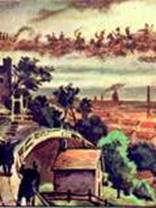 And this is not the only evidence of such a phenomenon. So, the famous battle of Waterloo (June 18, 1815) was observed a week later by residents of the Belgian town of Verviers. K. Flammarion, in his book Atmosphere, describes an example of such a mirage: “Based on the testimony of several trustworthy persons, I can report on a mirage that was seen in the city of Verviers (Belgium) in June 1815. One morning the inhabitants of the city saw in the sky army, and it was so clear that it was possible to distinguish the costumes of the gunners and even, for example, a cannon with a broken wheel, which was about to fall off ... It was the morning of the battle at Waterloo! " The described mirage is depicted in color watercolor by one of the eyewitnesses. The straight line distance from Waterloo to Verviers is over 100 km. There are cases when such mirages were observed at large distances - up to 1000 km. "The Flying Dutchman" should be attributed to just such mirages.
And this is not the only evidence of such a phenomenon. So, the famous battle of Waterloo (June 18, 1815) was observed a week later by residents of the Belgian town of Verviers. K. Flammarion, in his book Atmosphere, describes an example of such a mirage: “Based on the testimony of several trustworthy persons, I can report on a mirage that was seen in the city of Verviers (Belgium) in June 1815. One morning the inhabitants of the city saw in the sky army, and it was so clear that it was possible to distinguish the costumes of the gunners and even, for example, a cannon with a broken wheel, which was about to fall off ... It was the morning of the battle at Waterloo! " The described mirage is depicted in color watercolor by one of the eyewitnesses. The straight line distance from Waterloo to Verviers is over 100 km. There are cases when such mirages were observed at large distances - up to 1000 km. "The Flying Dutchman" should be attributed to just such mirages. Scientists have named one of the types of chronomyrage "drossolides", which means "dew drops" in Greek. It has been noticed that chronomirages most often occur in the early morning hours, when droplets of fog condense in the air. The most famous "drossolides" occurs quite regularly on the coast of Crete in the middle of summer, usually in the early morning hours. There are many testimonies of eyewitnesses who observed how a huge "battle canvas" appears over the sea near the castle of Franca-Castello - hundreds of people who have come together in mortal combat. Screams are heard, weapons clang. During the Second World War, the "battle of ghosts" terribly frightened the German soldiers who were then fighting in Crete. The Germans opened heavy fire from all types of weapons, but did not cause any harm to the phantoms. A mysterious mirage slowly approaches from the sea and disappears into the walls of the castle. Historians say that about 150 years ago a battle took place between the Greeks and the Turks, its image, lost in time, is observed over the sea. This phenomenon can be observed quite often in the middle of summer, in the early hours.
By the way, today eyewitnesses often observe not only battles of bygone times and ghost towns that once existed, but phantom cars. Several years ago, a company of Australians met on a night road a car that had once crashed under the control of their deceased friend. However, not only he was sitting in the ghost car, but also his young girlfriend, who survived in that catastrophe and is now in good health, having become a respectable lady.
What is the nature of such mirages?
According to one theory, with a special confluence of natural factors, visual information is imprinted in time and space. And with the coincidence of certain atmospheric, weather, etc. conditions, it again becomes visible to outside observers. According to another theory, in the area of battles in which thousands of people participate (and die), enormous psychic energy accumulates. Under certain conditions, it is "discharged" and visibly manifests past events.
In general, the ancient Egyptians, for example, believed that a mirage is a ghost of a country that no longer exists in the world.
Alpine legend
A group of tourists climbed one of the mountain peaks... The people were all young, except for the guide, the old mountaineer. At first, everyone walked quickly and briskly. But the higher the climbers climbed, the more difficult it became to go. Soon each of them felt very tired. Only the guide walked, as before, deftly jumped over crevices, quickly and easily climbed the ledges of the rocks.
A wonderful picture opened around. Wherever the eye could see, the snow-capped peaks of the mountains towered. The nearest ones glittered in the blinding sun. The distant peaks appeared bluish. Steep slopes went down, turning into gorges. Light green alpine meadows stood out as bright spots.
Finally they reached one of the side peaks of the mountain they were climbing. The sun had already sunk to the horizon, and its rays fell on people from the bottom up. And then the unexpected happened.
One of the young men overtook the guide and was the first to climb to the top. At the same moment, as he stepped on the rock, in the east, against the background of clouds, a huge shadow of a man appeared. It was visible so clearly that people stopped as if on command. But the guide calmly looked at the gigantic shadow, at the young people frozen in fright and, smiling, said:
- Do not be afraid! It happens - and also climbed the rock.
As he stood next to the tourist, another large shadow of a man appeared in the clouds.
The guide took off his warm felt hat and waved it. One of the shadows repeated his movement: a huge hand went up to his head, took off his hat and waved it. The young man raised his stick, and his gigantic shadow did the same. After that, each of the tourists wanted, of course, to climb the rock and see his shadow in the air. But soon the clouds covered the sun receding beyond the horizon, and the extraordinary shadows disappeared.
Superstition parade
Now, I think, it will not be difficult to understand how the luminous crosses appear in the sky, which in our time frighten other people.
The key here is that we do not always see this or that halo shape completely in the sky. In winter, during severe frosts, as already mentioned, two bright spots appear on both sides of the sun - parts of a vertical halo circle. This also happens with a horizontal circle passing through the sun. Most often, only that part of it is visible, which is adjacent to the luminary - in the sky, as it were, two light tails are visible, stretching from it to the right and to the left. The parts of the vertical and horizontal circles intersect and form, as it were, two crosses on either side of the sun.
In another case, we see at the sun a part of a horizontal circle intersected by a luminous column that goes up and down from the sun. And the cross is formed again.
Finally, it also happens: in the sky after sunset, a luminous pillar and the upper part of a vertical circle are visible. Crossing they give too
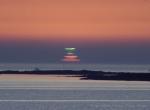 image of a large cross. And sometimes such a halo resembles an old knightly sword. And if it is still painted with dawn, then here is a bloody sword for you - a formidable reminder of heaven about future troubles!
image of a large cross. And sometimes such a halo resembles an old knightly sword. And if it is still painted with dawn, then here is a bloody sword for you - a formidable reminder of heaven about future troubles! The scientific explanation of the halo is a vivid example of how deceiving sometimes the external form of a natural phenomenon can be. It seems that it is something extremely mysterious, mysterious, but if you figure it out, not a trace remains of the "inexplicable".
It's easy to say - you'll figure it out! It took years, decades, centuries. Today, every person, interested in something, can look into a reference book, look through a textbook, and immerse himself in the study of special literature. Finally ask! And were there such opportunities in the middle, say, centuries? After all, then they had not yet accumulated such knowledge, and loners were engaged in science. The dominant worldview was religion, and the customary attitude was faith.
The French scientist K. Flammarion looked through the historical chronicles from this angle. And this is what turned out: the compilers of the chronicles did not in the least doubt the existence of a direct causal connection between the mysterious phenomena of nature and earthly affairs.
In 1118, during the reign of King Henry I of England, two full moons appeared in the sky at the same time, one in the west and the other in the east. In the same year, the king won the battle.
In 1120, a cross and a man, consisting of flames, appeared among the blood-red clouds. In the same year there was a bloody rain; everyone expected the end of the world, but it only ended in civil war.
In 1156, for several hours in a row, three iridescent circles glittered around the sun, and when they disappeared, three suns arose. The compiler of the chronicle saw in this phenomenon a hint of a quarrel between the king and the Bishop of Canterbury in England and of destruction after the seven-year siege of Milan in Italy.
The following year, three suns appeared again, and a white cross was visible in the middle of the moon; Of course, the chronicler immediately associated this with the strife that accompanied the election of the new pope.
In January 1514, three suns were visible in Württemberg, of which the average is greater than the lateral. At the same time, bloody and flaming swords appeared in the sky. In March of the same year, three suns and three moons were again visible. Then the Turks were defeated by the Persians in Armenia.
In 1526, at night in Württemberg, bloody military armor was visible in the air ...
In 1532, near Innsbruck, they saw in the air wonderful images of camels, wolves belching fire, and, finally, a lion in a circle of fire ...
Whether all these phenomena actually took place is not so important for us now. It is important that with their help, on their basis, real historical events were interpreted; that people then looked at the world through the prism of their
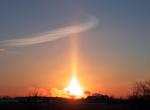 distorted representations and therefore saw what they wanted to see. Sometimes their imagination knew no bounds. Flammarion called the incredible fantastic pictures painted by the authors of the chronicles "examples of artistic exaggeration." Here is one of these "samples":
distorted representations and therefore saw what they wanted to see. Sometimes their imagination knew no bounds. Flammarion called the incredible fantastic pictures painted by the authors of the chronicles "examples of artistic exaggeration." Here is one of these "samples": “... In 1549 the moon was surrounded by halos and paraselenes (false moons), near which they saw a fiery lion and an eagle tearing its own chest. This was followed by burning cities, camels, Jesus Christ on an armchair with two robbers on the sides, and, finally, a whole congregation - apparently, the apostles. But the last change of phenomena was the most terrible of all. A man of enormous height appeared in the air, with a cruel appearance, threatening with a sword a young girl who was crying at his feet, asking for pardon ... "
What eyes were needed to see all this!
Some mysteries of optical phenomena
Color on glass
Winter evening. Light frost - about 10 °. You are traveling by tram (or by bus - it doesn't matter). The window starts to freeze. You can't make out anything through the glass, but the light of the lanterns is very clear. And at some point, the light of a street lamp causes a wonderful play of colors on the frozen window. The shades are so pure and beautiful that no artist can accurately reproduce them. After a few seconds, the layer of ice on the window reaches a thickness of a few tenths of a millimeter and the colors disappear. But it doesn't matter. Erase the frozen layer with your hand and repeat the observation - the colors will reappear.
Please note: a lamp with an incandescent lamp gives a purple-emerald halo, and a fluorescent lamp (mercury-quartz) is surrounded by a halo of yellow-violet colors.
This physical phenomenon is still poorly understood, and there is no exact explanation for it, however, it can be assumed that the play of color is caused by interference (the addition of light reflected from the upper and lower surfaces of the thinnest layer of moisture vapor frozen on the window glass).
This phenomenon is akin to what we observe when looking at a soap bubble shimmering with all the colors of the rainbow.
Colored rings
Draw a circle with black ink on a sheet of thick paper, on which a semicircle and arc stripes are located. Stick it on cardboard and make a top. When you rotate this top, instead of black patterns, multi-colored rings (purple, pink, blue or green, purple) will appear. The order of their arrangement varies depending on the direction of rotation of the top. The experiment is best done under electric lighting.
If this experience were shown on television, the effect would be the same: on a black-and-white TV screen, you would see multi-colored rings. Why this happens is unknown. Scientists have not yet found an explanation for this phenomenon.
Output: The physical nature of light has been of interest to people since time immemorial. Many outstanding scientists, throughout the development of scientific thought, fought to solve this problem. Over time, the complexity of the ordinary white ray was discovered, and its ability to change its behavior depending on the environment, and its ability to show signs inherent in both material elements and the nature of electromagnetic radiation. A light beam, subjected to various technical influences, began to be used in science and technology in the range from a cutting tool capable of processing the desired part with an accuracy of a micron to a weightless information transmission channel with practically inexhaustible possibilities.
But before being established modern look on the nature of light, and the light beam has found its application in human life, many optical phenomena have been identified, described, scientifically substantiated and experimentally confirmed, ubiquitous in the atmosphere of the earth, from the rainbow known to everyone to complex, periodic mirages. But, despite this, the bizarre play of light has always attracted and attracts a person. Neither the contemplation of the winter halo, nor the bright sunset, nor the broad, half-sky, strip of the northern lights, nor the modest lunar path on the water surface leaves anyone indifferent. A ray of light passing through the atmosphere of our planet, not only illuminates it, but also gives it a unique look, making it beautiful.
Of course, much more optical phenomena occur in the atmosphere of our planet, which are discussed in this essay. Among them there are both well-known to us and solved by scientists, and those who are still waiting for their discoverers. And we can only hope that, over time, we will witness more and more discoveries in the field of optical atmospheric phenomena, testifying to the versatility of an ordinary light beam.
Literature:
1. "Physics in nature", author - L. V. Tarasov, publishing house "Education", Moscow, 1988.
2. "Optical phenomena in nature", author - VL Bulat, publishing house "Prosveshchenie", Moscow, 1974.
3. "Conversations on Physics, Part II", author - MI Bludov, Publishing House "Prosveshchenie", Moscow, 1985.
4. "Physics 10", authors - G. Ya. Myakishev BB Bukhovtsev, publishing house "Prosveshchenie", Moscow, 1987.
5. "Physics 11", N. M. Shakhmaev, S. N. Shakhmaev, D. Sh. Shodiev, publishing house "Education", Moscow, 1991.
6. "Solving problems in physics", V. A. Shevtsov, Nizhne-Volzhsky book publishing house, Volgograd, 1999.
7. "Twilight", author - G.V. Rosenberg, from the introduction of Paragraph 2, Fizmatgiz, 1963
8. "Optics and Atmosphere", by P. R. Trubnikov and N. V. Pokusaev, Publishing House "Prosveshchenie" St. Petersburg 2002.
Optical phenomena in nature
Phenomena associated with the refraction of light.
Mirages.
In an inhomogeneous medium, light propagates non-linearly. If we imagine a medium in which the refractive index changes from bottom to top, and mentally divide it into thin horizontal layers, then, considering the conditions for the refraction of light when passing from layer to layer, we note that in such a medium the light beam should gradually change its direction.
The light beam undergoes such a curvature in the atmosphere, in which, for one reason or another, mainly due to its uneven heating, the refractive index of the air changes with height.
The air is usually heated from the soil, which absorbs energy from the sun's rays. Therefore, the air temperature decreases with altitude. It is also known that air density also decreases with height. It was found that with increasing altitude, the refractive index decreases, so the rays passing through the atmosphere are bent, bending towards the Earth. This phenomenon is called normal atmospheric refraction. As a result of refraction, the celestial bodies seem to us somewhat "raised" (higher than their true height) above the horizon. 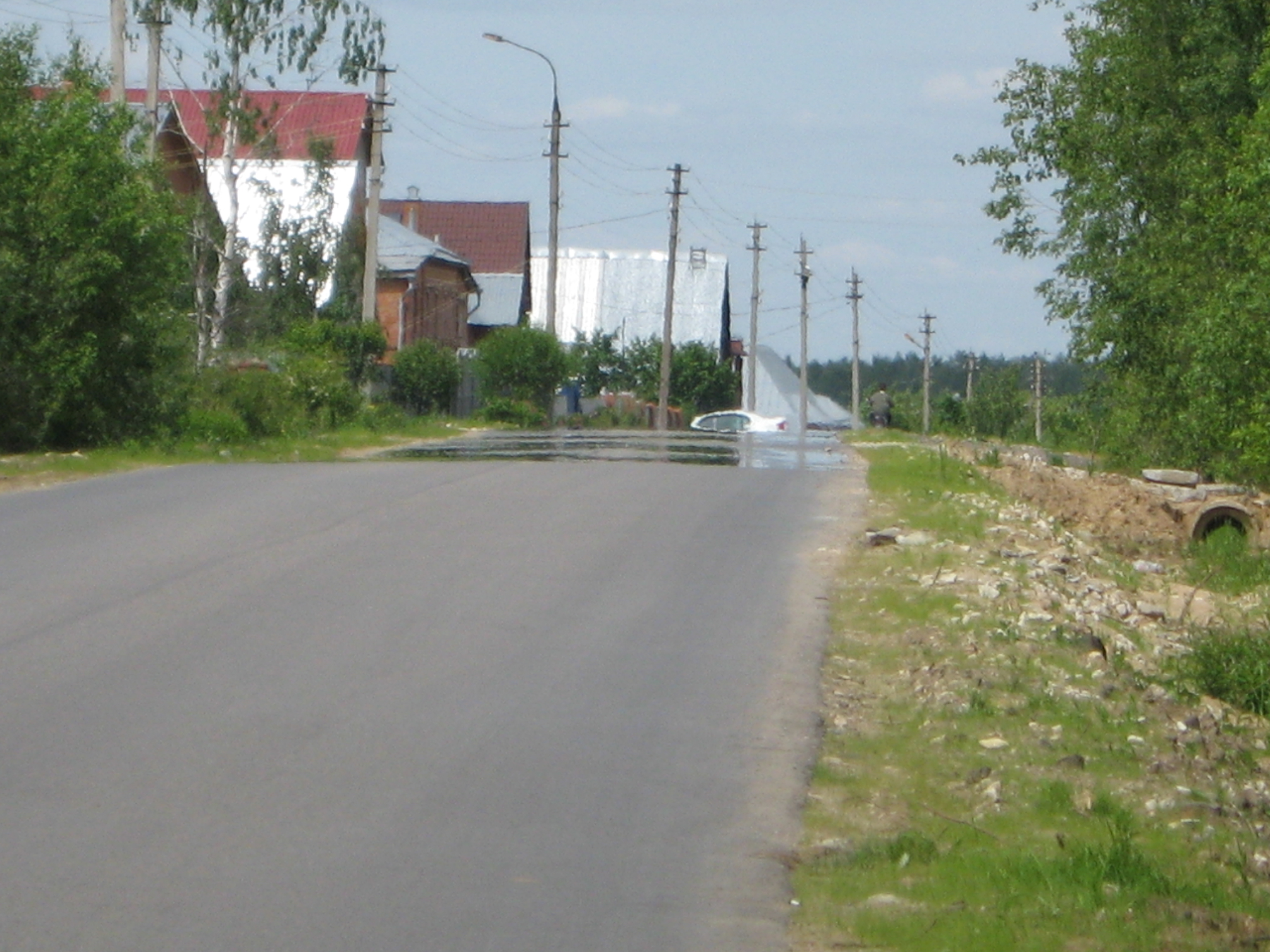
Mirages are divided into three classes.
The first class includes the most common and simple in origin, the so-called lake (or lower) mirages, which cause so many hopes and disappointments among desert travelers.
The explanation for this phenomenon is simple. The lower layers of air, warmed up from the soil, have not yet had time to rise upward; their refractive index of light is less than the upper ones. Therefore, the rays of light emanating from objects, bending in the air, fall into the eye from below.
There is no need to travel to Africa to see a mirage. It can be observed on a hot, quiet summer day and above the warmed surface of the asphalt highway.
Mirages of the second class are called upper or distant vision mirages.
They appear in the event that the upper layers of the atmosphere are for any reason, for example, when heated air gets there, especially rarefied. Then the rays emanating from earthly objects are bent more and reach the earth's surface, going at a large angle to the horizon. The observer's eye projects them in the direction in which they enter it.

Apparently in the fact that a large number of long-range mirages are observed on the coast Mediterranean Sea, the Sahara Desert is to blame. Hot air masses rise above it, then are carried away to the north and create favorable conditions for the emergence of mirages.
Upper mirages are also observed in Nordic countries when warm southerly winds blow. The upper layers of the atmosphere are heated, and the lower ones - cooled due to the presence of large masses of melting ice and snow.
Mirages of the third class - ultra-long-range vision - are difficult to explain. However, suggestions were made about the formation of giant air lenses in the atmosphere, about the creation of a secondary mirage, that is, a mirage from a mirage. It is possible that the ionosphere plays a role here, reflecting not only radio waves, but also light waves.
Light dispersion phenomena
A rainbow is a beautiful celestial phenomenon - it has always attracted the attention of a person. In the old days, when people still knew very little about the world around them, the rainbow was considered a "heavenly sign." So, the ancient Greeks thought that one hundred rainbow is the smile of the goddess Iris. A rainbow is observed on the opposite side of the Sun, against a background of rain clouds or rain. A multi-colored arc is usually located at a distance of 1-2 km from the observer Ra, sometimes it can be observed at a distance of 2-3 m against the background of water drops formed by fountains or water sprays
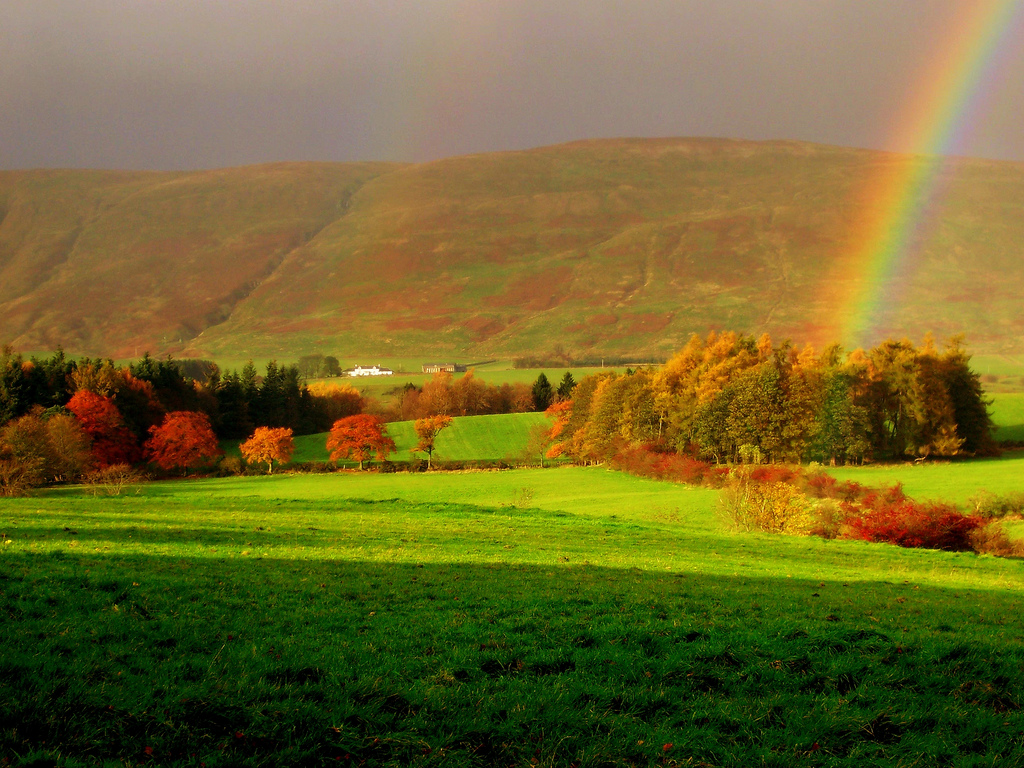
The rainbow has seven primary colors, smoothly passing one into the other.
The type of arc, the brightness of the colors, the width of the stripes depend on the size of the water droplets and their number. Large drops create a narrower rainbow with sharply distinguished colors, small ones create a vague, faded and even white arc. This is why a bright narrow rainbow is visible in the summer after a thunderstorm, during which large drops fall.
The rainbow theory was first presented in 1637 by R. Descartes. He explained the rainbow as a phenomenon associated with the reflection and refraction of light in raindrops.
The formation of colors and their sequence were explained later, after solving the complex nature of white light and its dispersion in the medium. The diffraction theory of the rainbow was developed by Erie and Pertner.
Light interference phenomena
White circles of light around the Sun or Moon, which result from the refraction or reflection of light by ice or snow crystals in the atmosphere, are called halos. Small crystals of water are present in the atmosphere, and when their edges form a right angle with the plane passing through the Sun, the observer and the crystals, a characteristic white halo surrounding the Sun becomes visible in the sky. So the edges reflect the rays of light with a deviation of 22 °, forming a halo. During the cold season, halos formed by ice and snow crystals on the earth's surface reflect sunlight and scatter it in different directions, creating an effect called diamond dust.
The most famous example of a large halo is the famous, often repeated "Brocken Vision". For example, a person standing on a hill or mountain, behind whose back the sun rises or sets, discovers that his shadow, falling on the clouds, becomes incredibly huge. This is due to the fact that the smallest droplets of fog refract and reflect sunlight in a special way. The phenomenon got its name from the Brocken peak in Germany, where, due to frequent fogs, this effect can be regularly observed.
Parghelia.
"Pargelius" in translation from Greek means "false sun". This is one of the halo shapes (see paragraph 6): one or more additional images of the Sun are observed in the sky, located at the same height above the horizon as the real Sun. Millions of vertical ice crystals reflecting the sun form this beautiful phenomenon.
Parghelia can be observed in calm weather with a low position of the Sun, when a significant number of prisms are positioned in the air so that their main axes are vertical, and the prisms slowly descend like small parachutes. In this case, the brightest refracted light enters the eye at an angle of 220 from the faces located vertically, and creates vertical pillars on either side of the Sun along the horizon. These pillars can be particularly bright in some places, giving the impression of a false Sun.
Polar lights.
One of the most beautiful optical phenomena in nature is the aurora borealis. It is impossible to convey in words the beauty of the polar lights, iridescent, flickering, flaming against the background of the dark night sky in the polar latitudes.
In most cases, auroras are green or blue-green with occasional spots or a pink or red border.
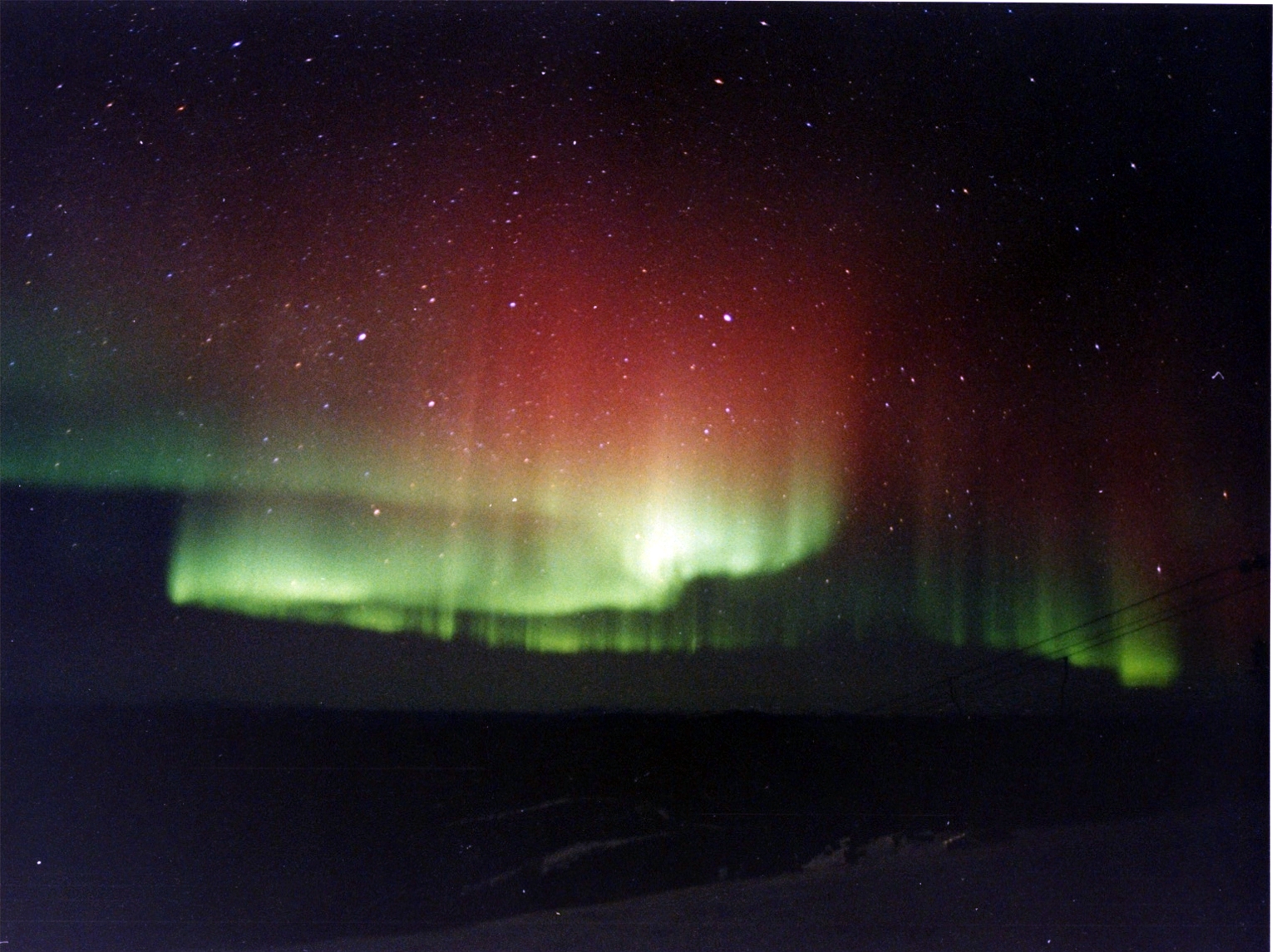
Auroras are observed in two main forms - in the form of ribbons and in the form of cloud-like spots. When the radiance is intense, it takes on the form of ribbons. Losing intensity, it turns into spots. However, many tapes disappear before they break into spots. The ribbons seem to hang in the dark space of the sky, resembling a giant curtain or drapery, usually stretching from east to west for thousands of kilometers. The height of the curtain is several hundred kilometers, its thickness does not exceed several hundred meters, and it is so delicate and transparent that the stars are visible through it. The lower edge of the curtain is quite distinctly and sharply outlined and is often tinted red or pinkish, reminiscent of the border of the curtain, the upper edge is gradually lost in height and this creates a particularly effective impression of the depth of space.
There are four types of auroras:
1. Homogeneous arc - the luminous strip has the simplest, quietest shape. It is brighter from below and gradually disappears upward against the background of the glow of the sky;
2. Radiant arc - the tape becomes somewhat more active and mobile, it forms small folds and trickles;
3. Radiant stripe - with an increase in activity, larger folds are superimposed on small ones;
4. With increased activity, folds or loops expand to enormous sizes (up to hundreds of kilometers), the lower edge of the ribbon shines with a pink light. When the activity subsides, the folds disappear and the tape returns to a uniform shape. This suggests that a homogeneous structure is the main form of the aurora, and folds are associated with increased activity.
Auroras of a different kind often appear. They cover the entire polar region and are very intense. They occur during an increase in solar activity. These auroras appear as the whitish-green glow of the entire polar cap. Such auroras are called squalls.
Conclusion
Once the mirages "The Flying Dutchman" and "Fata Morgana" terrified sailors. On the night of March 27, 1898, among The Pacific The crew of the ship "Matador" was frightened by the vision when, in calm at midnight, they saw a vessel 2 miles (3.2 km) away, which was struggling with a strong storm. All these events actually took place at a distance of 1700 km.
Today everyone who knows the laws of physics, or rather its section of optics, can explain all these mysterious phenomena.
In my work, I have not described all the optical phenomena of nature. There are a lot of them. We admire the blue color of the sky, the ruddy dawn, the glowing sunset - these phenomena are explained by the absorption and scattering of sunlight. Working with additional literature, I made sure that the questions that arise when observing the world around us, you can always find answers. True, you need to know the basics of natural sciences.
CONCLUSION: Optical phenomena in nature are explained by the refraction or reflection of light, or the wave properties of light - dispersion, interference, diffraction, polarization, or quantum properties of light. The world is mysterious, but cognizable.
At school he is studying the topic "Optical phenomena in the atmosphere" 6th grade. However, it is of interest not only to the inquisitive child's mind. Optical phenomena in the atmosphere, on the one hand, unite the rainbow, the change in the color of the sky during sunrises and sunsets, seen by everyone more than once. On the other hand, they include mysterious mirages, false moons and suns, impressive halos that terrified people in the past. The mechanism of formation of some of them remains incomprehensible even today, but the general principle by which optical phenomena "live" in nature has been well studied by modern physics.
Air shell
The Earth's atmosphere is an envelope composed of a mixture of gases and extends about 100 km above sea level. The density of the air layer changes with distance from the earth: its greatest value is at the surface of the planet, with height it decreases. The atmosphere is not static formation. The layers of the gas envelope are constantly moving and mixing. Their characteristics change: temperature, density, movement speed, transparency. All these nuances affect the sun's rays rushing to the surface of the planet.
Optical system
The processes occurring in the atmosphere, as well as its composition, contribute to the absorption, refraction and reflection of light rays. Some of them reach the target - the earth's surface, the other is scattered or redirected back into outer space. As a result of the bending and decay of part of the rays into a spectrum, and so on, various optical phenomena are formed in the atmosphere.
Atmospheric optics
At a time when science was just in its infancy, people explained optical phenomena based on the prevailing ideas about the structure of the Universe. The rainbow connected the human world with the divine, the appearance of two false Suns in the sky testified to the approaching catastrophes. Today, most of the phenomena that frightened our distant ancestors have received a scientific explanation. Atmospheric optics is studying such phenomena. This science describes optical phenomena in the atmosphere based on the laws of physics. She is able to explain, during the day, and during sunset and dawn, it changes color, how a rainbow is formed and where mirages come from. Numerous studies and experiments today make it possible to understand such optical phenomena in nature as the appearance of luminous crosses, Fata Morgana, and rainbow halos.
Blue sky
The color of the sky is so familiar that we rarely wonder why it is. Nevertheless, physicists know the answer well. Newton proved that a ray of light is decomposed into a spectrum under certain conditions. When passing through the atmosphere, its part corresponding to the blue color is better scattered. The red section is characterized by a longer wavelength and is 16 times inferior to the violet in the degree of scattering.
At the same time, we see the sky not purple, but blue. The reason for this lies in the features of the retina and the ratio of the spectrum areas in sunlight. Our eyes are more sensitive to blue, and the violet region in the spectrum of a luminary is less intense than blue.
Scarlet sunset
When people figured it out, optical phenomena ceased to be evidence or an omen for them. terrible events... However, a scientific approach does not prevent you from getting from colorful sunsets and gentle sunrises. Bright reds and oranges, along with pink and blue, gradually give way to night darkness or morning light. It is impossible to observe two identical sunrises or sunsets. And the reason for this lies in the same mobility of atmospheric layers and changing weather conditions.
During sunsets and sunrises, the sun's rays travel a longer distance to the surface than during the day. As a result, diffuse violet, blue and green go to the sides, and direct light is colored in red and orange. Clouds, dust or ice particles suspended in the air contribute to the picture of dusk and dawn. Light refracts as it passes through them and colors the sky in a variety of shades. On the horizon opposite to the Sun, one can often observe the so-called Belt of Venus - a pink stripe separating the dark night sky and the blue day sky. The beautiful optical phenomenon, named after the Roman goddess of love, is seen before sunrise and after sunset. 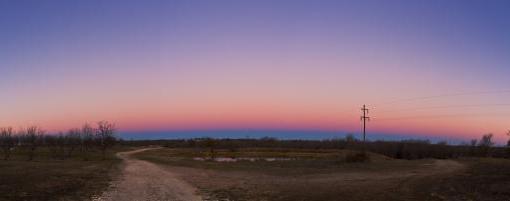
Rainbow bridge
Perhaps no other light phenomena in the atmosphere recall as many mythological plots and fairy-tale images as they are associated with a rainbow. An arc or circle, consisting of seven colors, is known to everyone from childhood. A beautiful atmospheric phenomenon that occurs during rain, when the sun's rays pass through the drops, fascinates even those who have thoroughly studied its nature.
And the physics of the rainbow is not a secret for anyone today. Sunlight, refracted by drops of rain or fog, splits. As a result, the observer sees seven colors of the spectrum, from red to violet. It is impossible to define the boundaries between them. Colors smoothly blend into each other through several shades.
When observing a rainbow, the sun is always behind the person's back. The center of the smile of Iris (as the ancient Greeks called the rainbow) is located on the line passing through the observer and the daylight. Usually the rainbow appears as a semicircle. Its size and shape depend on the position of the Sun and the point at which the observer is. The higher the luminary above the horizon, the lower the circle of the possible appearance of a rainbow falls. When the Sun exceeds 42 degrees above the horizon, an observer on the Earth's surface cannot see the rainbow. The higher above sea level a person who wants to admire Iris's smile is located, the more likely he will see not an arc, but a circle.
Double, narrow and wide rainbow
Often, along with the main one, you can see the so-called side rainbow. If the first is formed as a result of a single reflection of light, then the second is the result of double. In addition, the main rainbow differs in a certain order of colors: red is located on the outside, and purple on the inner, which is closer to the Earth's surface. The side "bridge" is a spectrum inverse in the sequence: the violet is at the top. This is because the double reflection of the raindrops leaves the rays at different angles.
Rainbows vary in color intensity and width. The brightest and rather narrow ones appear after a summer thunderstorm. The large drops, typical of this kind of rain, give rise to a highly visible rainbow with distinctly distinguishable colors. Small droplets produce a more vague and less visible rainbow.
Optical phenomena in the atmosphere: aurora
One of the most beautiful atmospheric optical phenomena is the aurora. It is typical for all planets with a magnetosphere. On Earth, auroras are observed at high latitudes in both hemispheres, in the zones surrounding the planet's magnetic poles. Most often, you can see a greenish or blue-green glow, sometimes complemented by flashes of red and pink along the edges. The intense aurora is shaped like ribbons or folds of fabric that fade into spots. Stripes several hundred kilometers high stand out well along the lower edge against the background of the dark sky. The upper limit of the aurora is lost in the sky.
These beautiful optical phenomena in the atmosphere still keep their secrets from people: the mechanism of the emergence of some types of glow, the cause of the crackle that occurs during sharp flashes, has not been fully studied. However, the general picture of the formation of auroras is known today. The sky above the north and south poles is decorated with a greenish-pink glow as charged particles from the solar wind collide with the atoms of the upper layers. earth's atmosphere... The latter, as a result of interaction, receive additional energy and emit it in the form of light.
Halo
The sun and the moon often appear before us surrounded by a glow that resembles a halo. This halo is a highly visible ring around the light source. In the atmosphere, it is most often formed due to the smallest particles of ice, which are high above the Earth. The characteristics of the phenomenon change depending on the shape and size of the crystals. Often a halo takes the form of a rainbow circle as a result of the decomposition of a light beam into a spectrum. ![]()
An interesting kind of phenomenon is called parhelia. As a result of the refraction of light in ice crystals at the level of the Sun, two bright spots are formed, reminiscent of a daylight. Descriptions of this phenomenon can be found in historical chronicles. In the past, it was often considered a harbinger of dire events.
Mirage
Mirages are also optical phenomena in the atmosphere. They arise as a result of the refraction of light at the border between layers of air that are significantly different in density. The literature describes many cases when a traveler in the desert saw oases or even cities and castles that could not be nearby. Most often these are "lower" mirages. They appear over a flat surface (desert, asphalt) and represent a reflected image of the sky, which appears to the observer as a reservoir.
The so-called upper mirages are less common. They form over a cold surface. Upper mirages are straight and inverted, sometimes they combine both positions. The most famous representative of these optical phenomena is Fata Morgana. This is a complex mirage that combines several types of reflections at once. Real-life objects appear before the observer, repeatedly reflected and mixed. 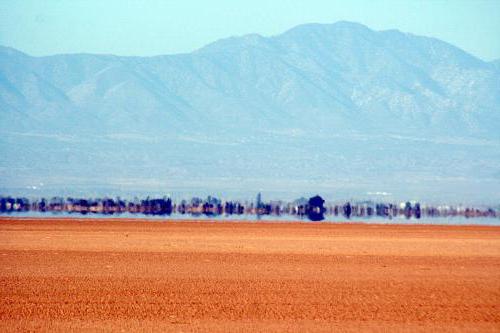
Atmospheric electricity
Electrical and optical phenomena in the atmosphere are often mentioned together, although the reasons for their occurrence are different. The polarization of clouds and the formation of lightning are associated with processes occurring in the troposphere and ionosphere. Giant spark discharges usually form during a thunderstorm. Lightning occurs inside clouds and can strike the ground. They are a threat to human life, and this is one of the reasons for the scientific interest in such phenomena. Some of the properties of lightning are still a mystery to researchers. Today, the cause of the occurrence of ball lightning is unknown. As with some aspects of the theory of auroras and mirages, electrical phenomena continue to intrigue scientists.
The optical phenomena in the atmosphere, briefly described in the article, are becoming more and more understandable for physicists every day. At the same time, they, like lightning, never cease to delight people with their beauty, mystery and sometimes grandeur.
Many people like funny pictures that trick their visual perception. But did you know that nature also knows how to create optical illusions? Moreover, they look an order of magnitude more impressive than those made by man. These include dozens of natural phenomena and formations, both rare and fairly widespread. Northern lights, halo, green ray, lenticular clouds - only a small part of them. For your attention - 25 stunning optical illusions created by nature.
Fire waterfall "Horse tail"
Every February the streams turn a fiery orange
This beautiful and at the same time intimidating waterfall is located in the central part of Yosemite National Park. It is called Horsetail Fall (translated as "horse tail"). Every year, for 4-5 days in February, tourists can see a rare phenomenon - the rays of the setting sun are reflected in the falling streams of water. At these moments, the waterfall turns into a fiery orange color. It seems that incandescent lava flows from the top of the mountain, but this is just an optical illusion.
The Horse Tail Waterfall consists of two cascading streams, its total height reaches 650 meters.
False sun
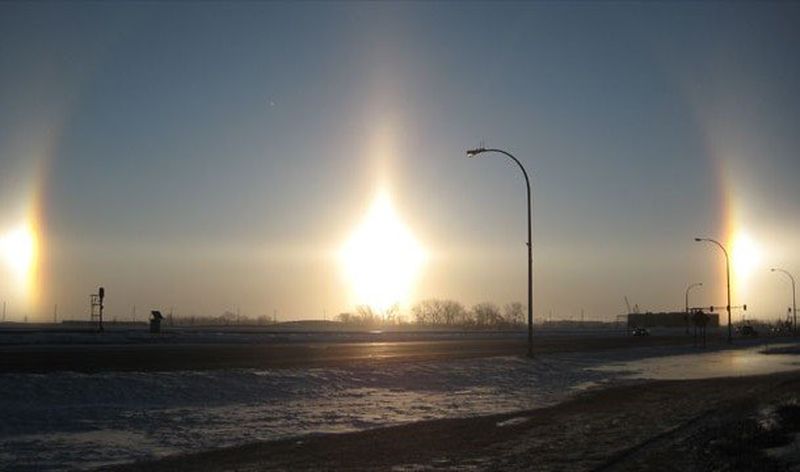
Real Sun and two false
If the Sun is low above the horizon and microscopic ice crystals are present in the atmosphere, observers may notice several bright iridescent specks to the right and left of the Sun. These bizarre halos faithfully follow our luminary across the firmament, in whatever direction it is directed.
In principle, this atmospheric phenomenon is considered to be quite common, but the effect is difficult to notice.
It is interesting: On the rare occasion that sunlight passes through cirrus clouds at the desired angle, these two spots become as bright as the Sun itself.
The effect is best observed in the early morning or late evening in the polar regions.
Fata Morgana

Fata morgana - the rarest optical illusion
Fata morgana is a complex optical atmospheric phenomenon. It is extremely rare. In fact, Fata Morgana "consists" of several forms of mirages, due to which distant objects are distorted and "bifurcated" for the observer.
It is known that Fata Morgana occurs when several alternating layers of air with different densities are formed in the lower atmosphere (usually due to temperature differences). Under certain conditions, they give mirror reflections.
Due to the reflection and refraction of light rays, real-life objects can create several distorted images on the horizon or even above it at once, which partially overlap each other and rapidly change over time, thereby creating a striking picture of Fata Morgana.
Light pole
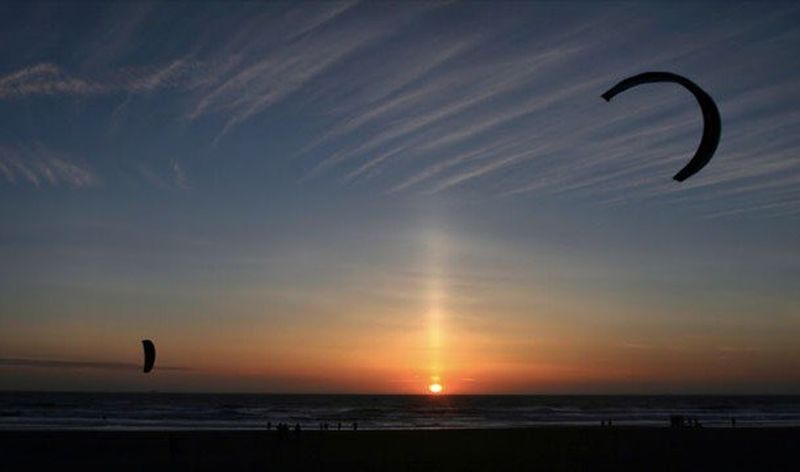
A pillar of light emanating from the sun descending beyond the horizon
We become witnesses of light (or solar) pillars quite often. This is the name of a common type of halo. This optical effect looks like a vertical streak of light that extends from the sun at sunset or sunrise. A column of light can be observed when light in the atmosphere bounces off the surface of tiny ice crystals in the form of ice plates or miniature hexagonal rods. Crystals of this shape are most often formed in high cirrostratus clouds. But if the air temperature is low enough, they can appear in less high layers of the atmosphere. We think it is not worth explaining why light columns are most often observed in winter.
Broken ghost
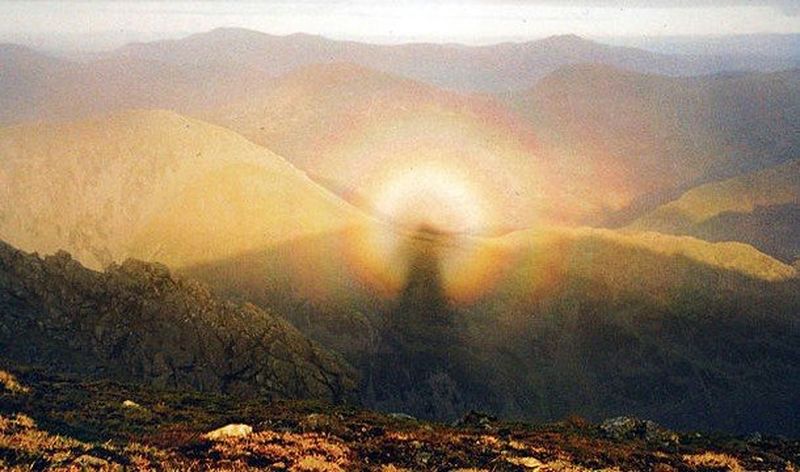
Under certain conditions, the shadow can look like a ghost.
When there is a thick fog outside, you can observe an interesting optical phenomenon - the so-called Broken ghost. To do this, you just need to turn your back to the main light source. The observer will be able to see his own shadow lying on the fog (or cloud if you are in a mountainous area).
It is interesting: If the light source, as well as the object on which the shadow is cast, are static, it will repeat any movement of the person. But in a completely different way, the shadow will be displayed on a moving "surface" (for example, on fog). In such conditions, it can oscillate, creating the illusion that a dark, foggy silhouette is moving. One gets the impression that this is not a shadow belonging to the observer, but a real ghost.
Atlantic road in Norway
![]()
There are probably no more scenic highways in the world than the Atlantic Road in Møre og Romsdal, Norway.
The unique highway runs across the North Atlantic coast and includes as many as 12 bridges connecting the individual islands with a road surface.
The most amazing place on the Atlantic Road is the Storseisundet Bridge. From a certain angle, it may seem that it is not completed, and all passing cars, going up, approach the cliff, and then fall down.
The total length of this bridge, opened in 1989, is 8.3 kilometers.
In 2005, the Atlantic Road was named “Norway's Building of the Century”. And the journalists of the British edition of The Guardian awarded it the title of the best tourist route in this northern country.
Moon illusion
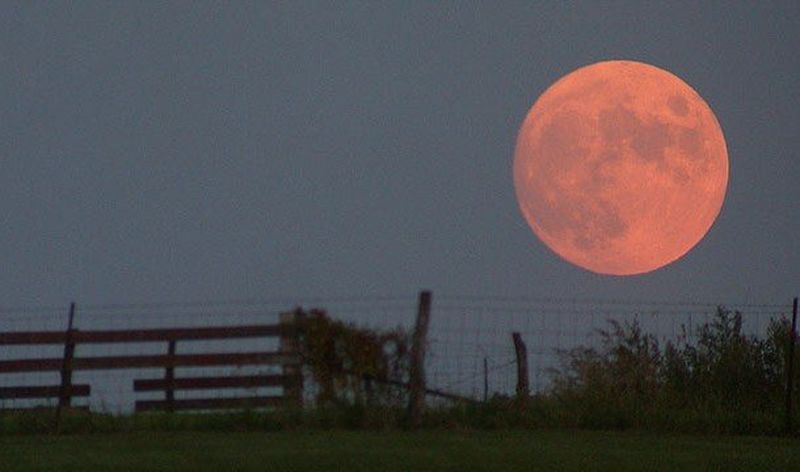
The Moon, located above the horizon, seems to be large.
When the full moon bends low on the horizon, it is visually much larger than when it is high in the sky. This phenomenon is seriously puzzling thousands of inquisitive minds trying to find some reasonable explanation for it. But in reality, this is a common illusion.
The most straightforward way to confirm the illusory nature of this effect is to hold a small rounded object (for example, a coin) in your outstretched hand. Comparing the size of this object with the "huge" Moon at the horizon and the "tiny" Moon in the sky, you will be surprised, because you will understand that its relative size does not undergo any changes. You can also roll up a piece of paper in the shape of a tube and look through the hole formed exclusively at the Moon, without any objects surrounding it. Again, the illusion will disappear.
It is interesting: Most scientists, explaining the Lunar illusion, refer to the theory of "relative size". It is known that the visual perception of the size of an object visible by a person is determined by the dimensions of other objects observed by him at the same time. When the Moon is low above the horizon, other objects (houses, trees, etc.) fall into the field of view of a person. Against their background, our night star seems larger than it actually is.
Shadows of the clouds

Cloud shadows look like small islands
On a sunny day from a great height it is very interesting to observe the shadows cast by clouds on the surface of our planet. They resemble small, constantly moving islands in the ocean. Unfortunately, ground-based observers will not be able to appreciate the magnificence of this picture.
Moth Atlas

Moth Atlas
The huge moth atlas is found in tropical forests in South Asia. It is this insect that holds the record for wing surface area (400 square centimeters). In India, this moth is bred to produce silk threads. The gigantic insect produces brown silk that looks like wool.
Due to their large size, atlas moths fly disgustingly, moving slowly and awkwardly in the air. But the unique coloring of their wings helps to camouflage in their natural habitat. Thanks to her, the atlas literally merges with the trees.
Dew on the web

Dew on the web
In the morning or after rain, tiny water droplets resembling a necklace can be seen on the cobwebs. If the web is very thin, the observer may have the illusion that the drops literally float in the air. And in the cold season, the cobweb can be covered with frost or frozen dew, such a picture looks no less impressive.
Green ray

Green ray
A short-term flash of green light, observed an instant before the appearance of the solar disk from the horizon (most often, at the sea) or at the moment when the sun is hiding behind it, is called a green ray.
You can become a witness of this amazing phenomenon if three conditions are met: the horizon must be open (steppe, tundra, sea, mountainous terrain), the air must be clean, and the region of sunset or sunrise must be free of clouds.
As a rule, the green ray is visible for no more than 2-3 seconds. To significantly increase the time interval of its observation at the time of sunset, you need to quickly run up the earthen embankment or climb stairs immediately after the appearance of the green ray. If the Sun rises, you need to move in the opposite direction, that is, down.
It is interesting: During one of the flights over the South Pole, the famous American pilot Richard Byrd saw a green ray for 35 minutes! A unique event occurred at the end of the polar night, when the upper edge of the solar disk first appeared over the horizon and slowly moved along it. It is known that at the poles the solar disk moves almost horizontally: the speed of its vertical rise is very low.
Physicists attribute the effect of the green ray to the refraction (i.e., refraction) of sunlight as it travels through the atmosphere. Interestingly, at the time of sunset or sunrise, we should have seen blue or purple rays first. But their wavelength is so small that when passing through the atmosphere, they are almost completely scattered and do not reach the terrestrial observer.
The peri-zenith arch

The peri-zenith arch
In fact, the zenith arch looks like a rainbow turned upside down. To some people, it even resembles a huge multi-colored smiley face in the sky. This phenomenon is formed due to the refraction of the sun's rays passing through ice crystals of a certain shape soaring in the clouds. The arc centers at the zenith parallel to the horizon. The top color of this rainbow is blue, the bottom color is red.
Halo
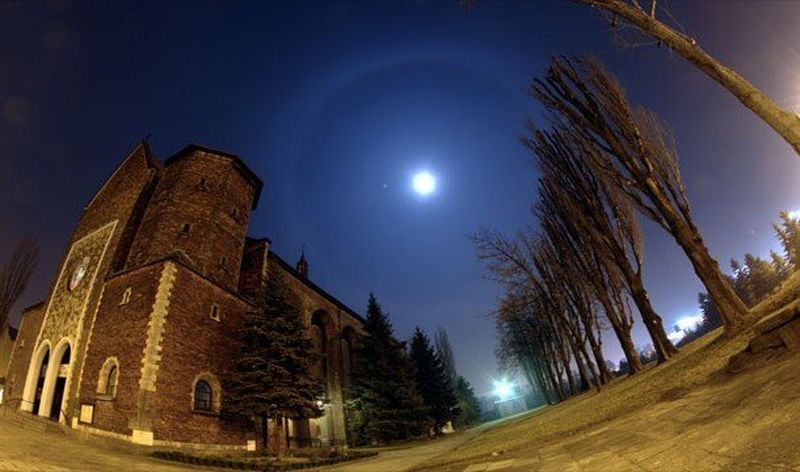
Halo around the moon
Halo is one of the most famous optical phenomena, observing which a person can see a luminous ring around a powerful light source.
During the day, the halo appears around the sun, at night - around the moon or other sources, for example, street lamps. There are many types of halos (one of them is the aforementioned false sun illusion). Almost all halos are caused by the refraction of light as it passes through ice crystals, which are concentrated in cirrus clouds (located in the upper troposphere). The type of halo is determined by the shape and arrangement of these miniature crystals.
Pink glare of the Sun

Pink glare of the Sun
Probably every inhabitant of our planet saw a pink glow. This interesting phenomenon is observed at the moment when the sun sets over the horizon. Then mountains or other vertical objects (for example, multi-storey buildings) are painted in a pale pink shade for a short time.
Twilight rays
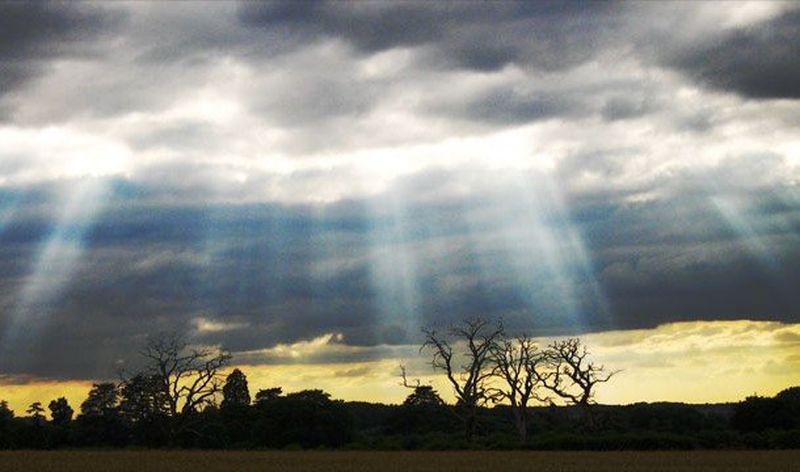
Twilight rays
Scientists call twilight rays a common optical phenomenon that looks like the alternation of many light and dark stripes in the firmament. Moreover, all these stripes diverge from the current location of the Sun.
Twilight rays are one of the manifestations of the play of light and shadow. We are sure that the air is completely transparent, and the rays of light that pass through it are invisible. But in the case of the presence of the smallest droplets of water or dust particles in the atmosphere, sunlight is scattered. A whitish haze forms in the air. It is almost invisible in clear weather. But in cloudy conditions, dust or water particles that are in the shadow of clouds are less illuminated. Therefore, shaded areas are perceived by observers as dark stripes. Well-lit areas alternating with them, on the contrary, seem to us as bright light stripes.
A similar effect is observed when the sun's rays, making their way through the cracks into a dark room, form bright light paths, illuminating dust particles floating in the air.
It is interesting: Twilight rays are called differently in different countries. The Germans use the expression “The sun drinks water”, the Dutch use the expression “The sun is on its feet”, and the British call the twilight rays “Jacob's ladder” or “the ladder of angels”.
Anti-twilight rays

Anti-twilight rays emanate from a point on the horizon opposite the setting sun
These rays are observed at the time of sunset on the eastern side of the firmament. They, like the twilight rays, fan out, the only difference between them is their location relative to the celestial body.
It may seem that the anti-twilight rays are converging at some point beyond the horizon, but this is only an illusion. In fact, the rays of the Sun propagate strictly along straight lines, but when these lines are projected onto the spherical atmosphere of the Earth, arcs are formed. That is, the illusion of their fan-shaped divergence is determined by the perspective.
northern Lights

Northern lights in the night sky
The sun is very unstable. Sometimes powerful explosions occur on its surface, after which the smallest particles of solar matter (solar wind) are directed towards the Earth at great speed. It takes them about 30 hours to reach Earth.
The magnetic field of our planet deflects these particles to the poles, as a result of which extensive magnetic storms begin there. Protons and electrons entering the ionosphere from outer space interact with it. The thin layers of the atmosphere begin to glow. The whole sky is painted with multi-colored dynamically moving patterns: arcs, bizarre lines, crowns and spots.
It is interesting: You can observe the northern lights in high latitudes of each hemisphere (therefore, it would be more correct to call this phenomenon "aurora borealis"). The geography of the places where people can contemplate this impressive natural phenomenon expands significantly only during periods of high solar activity. Surprisingly, there are also auroras on other planets in our solar system.
The shapes and colors of the colorful glow of the night sky change rapidly. Interestingly, auroras occur exclusively in the altitude ranges from 80 to 100 and from 400 to 1000 kilometers above ground level.
Krushinnitsa

Buckthorn is a butterfly with incredibly realistic natural camouflage
In early April, when the weather is stable and warm and sunny, you can see a beautiful light speck flitting from one spring flower to another. This is a butterfly called buckthorn or lemongrass.
The wingspan of the buckthorn is about 6 centimeters, the length of the wings is from 2.7 to 3.3 centimeters. Interestingly, the coloration of males and females is different. Males have bright greenish lemon wings, and females are lighter, almost white.
Krušinitsa has amazingly realistic natural camouflage. It is very difficult to distinguish it from plant leaves.
Magnetic hill

Cars seem to be rolling uphill under the influence of an unknown force
There is a hill in Canada where extraordinary things happen. Having parked the car near its foot and engaging in neutral, you will see that the car begins to roll (without any help) upward, that is, in the direction of the rise. Many people attribute the amazing phenomenon to the effect of an incredibly powerful magnetic force that makes cars roll uphill and reach speeds of up to 40 kilometers per hour.
Unfortunately, there is no magnetism or magic here. It's all about the usual optical illusion. Due to the peculiarities of the relief, a small slope (about 2.5 degrees) is perceived by the observer as an ascent upward.
The main factor in creating a similar illusion, observed in many other places around the globe, is the zero or minimum visibility of the horizon. If a person does not see it, then it becomes quite difficult to judge the inclination of the surface. Even objects, in most cases located perpendicular to the ground (for example, trees), can lean in any direction, misleading the observer even more.
Salt deserts
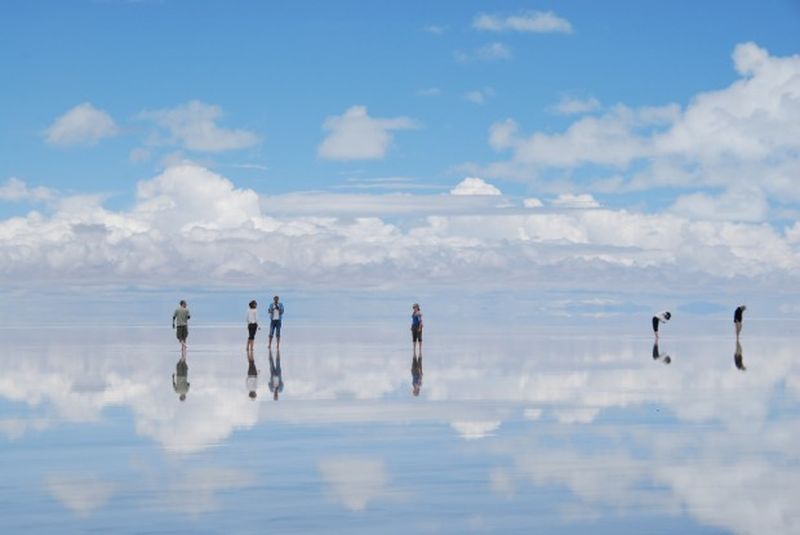
It seems like all these people are soaring in the sky.
Salt deserts are found in all corners of the earth. People in the middle of them have a distorted perception of space due to the lack of any reference points.
In the photo you can see a dried-up salt lake located in the southern part of the Altiplano plain (Bolivia) and called the Uyuni Salt Flats. This place is located at an altitude of 3.7 kilometers above sea level, and its total area exceeds 10.5 thousand square kilometers. Uyuni is the largest salt marsh on our planet.
The most common minerals found here are halite and gypsum. And the thickness of the salt layer on the surface of the salt marsh in some places reaches 8 meters. The total salt reserves are estimated at 10 billion tons. On the territory of Uyuni there are several hotels built from salt blocks. Furniture and other interior items are also made from it. And on the walls of the rooms there are announcements: the administration politely asks guests not to lick anything. By the way, you can spend the night in such hotels for only $ 20.
It is interesting: During the rainy season, Uyuni is covered with a thin layer of water, making it the largest mirror surface on Earth. In the midst of an infinite mirror space, observers have the impression that they are soaring in the sky or even on another planet.
Wave
![]()
Sand dunes turned to stone
The Wave is a naturally formed sand and rock gallery located on the border of the US states of Utah and Arizona. Popular US national parks are located nearby, so the Wave attracts hundreds of thousands of tourists every year.
Scientists claim that these unique rocky formations were formed for more than one million years: the sand dunes gradually hardened under the influence of environmental conditions. And the wind and rain, which for a long time influenced these formations, polished their forms and gave them such an unusual look.
Apache head
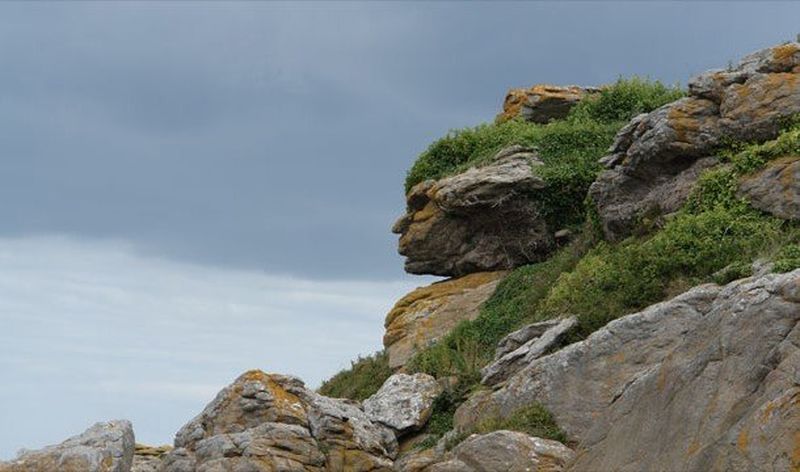
It's hard to believe that this rocky formation formed without human intervention.
This natural rock formation in France vividly illustrates our ability to recognize familiar shapes, such as human faces, in surrounding objects. Scientists recently discovered that we even have a special part of the brain that is responsible for recognizing faces. Interestingly, the visual perception of a person is designed in such a way that any objects similar in outlines to faces are noticed by us faster than other visual stimuli.
There are hundreds of natural formations in the world that exploit this human ability. But you must agree: the mountain range in the shape of the head of the Apache Indian is probably the most striking of them. By the way, tourists who had the opportunity to contemplate this unusual rocky formation located in the French Alps cannot believe that it was formed without human intervention.
Wasteland Guard

An Indian in a traditional headdress and headphones in his ears - where else can you see that?
Wasteland Guardian (also called "Indian Head") is a unique geoformation located near the Canadian city of Madisen Hat (southeastern part of the province of Alberta). When looking at it from a great height, it becomes obvious that the relief of the area forms the outlines of the head of a local aborigine in a traditional Indian headdress, staring somewhere to the west. Moreover, this Indian also listens to modern headphones.
In fact, what looks like a wire from a headphone is the path that leads to the oil rig, and the liner is the well itself. The height of the "Indian head" is 255 meters, the width is 225 meters. By comparison, the famous Mount Rushmore bas-relief, which carved the faces of four American presidents, is only 18 meters high.
Wasteland was formed naturally by the weathering and erosion of soft clay-rich soil. According to scientists, the age of this geoformation does not exceed 800 years.
Lenticular (lenticular) clouds
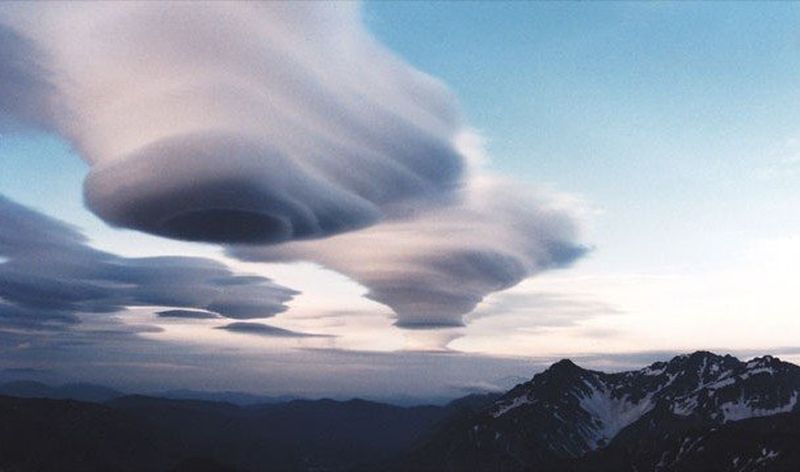
Lenticular clouds look like huge UFOs
A unique feature of lenticular clouds is that no matter how strong the wind is, they remain stationary. Air currents sweeping over the earth's surface flow around obstacles, due to which air waves are formed. At their edges, lenticular clouds are formed. In their lower part, there is a continuous process of condensation of water vapor rising from the surface of the earth. Therefore, lenticular clouds do not change their position. They just hover in the sky in one place.
Lenticular clouds most often form on the leeward side of mountain ranges or over individual peaks at an altitude of 2 to 15 kilometers. In most cases, their appearance signals an approaching atmospheric front.
It is interesting: Due to their unusual shape and absolute immobility, people often mistake lenticular clouds for UFOs.
Thunderbolt clouds
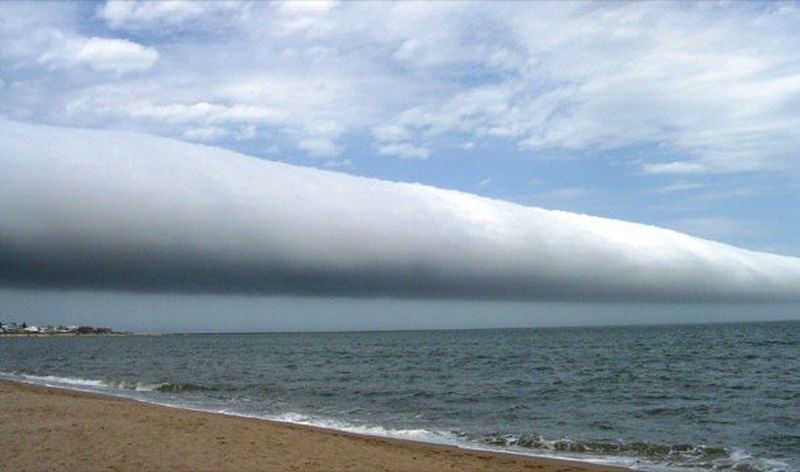
Such a sight inspires fear, you must admit!
Creepy clouds with a thunderstorm are seen quite often in flat areas. They sink very low above the ground. There is a feeling that if you go up to the roof of the building, you can reach them with your hand. And sometimes it may seem that such clouds are in general contact with the surface of the earth.
A storm shaft (another name is a squall gate) is visually similar to a tornado. Fortunately, in comparison with this natural phenomenon, it is not so dangerous. A thunderbolt is simply a low, horizontally oriented area of a thundercloud. It is formed in its front part during fast movement. And the squall gate acquires an even and smooth shape under conditions of active ascending air movement. Such clouds, as a rule, form during the warm season (from mid-spring to mid-autumn). Interestingly, the life span of thunderstorms is very short - from 30 minutes to 3 hours.
Agree, many of the above phenomena seem truly magical, even though their mechanisms can be easily explained from a scientific point of view. Nature, without the slightest human participation, creates amazing optical illusions that amaze the imagination of even many researchers who have seen in their lifetime. How can one not admire her greatness and power?


